false 0001759138 0001759138 2023-11-09 2023-11-09
UNITED STATES
SECURITIES AND EXCHANGE COMMISSION
Washington, D.C. 20549
FORM 8-K
CURRENT REPORT
Pursuant to Section 13 or 15(d)
of The Securities Exchange Act of 1934
November 9, 2023
Date of Report (Date of earliest event reported)
CABALETTA BIO, INC.
(Exact name of Registrant as Specified in its Charter)
|
|
|
|
|
| Delaware |
|
001-39103 |
|
82-1685768 |
(State or other jurisdiction
of incorporation) |
|
(Commission
File Number) |
|
(I.R.S. Employer
Identification No.) |
|
|
|
| 2929 Arch Street, Suite 600, Philadelphia, PA |
|
19104 |
| (Address of principal executive offices) |
|
(Zip Code) |
(267) 759-3100
(Registrant’s telephone number, including area code)
Not Applicable
(Former name or former address, if changed since last report)
Check the appropriate box below if the Form 8-K filing is intended to simultaneously satisfy the filing obligation of the registrant under any of the following provisions:
| ☐ |
Written communications pursuant to Rule 425 under the Securities Act (17 CFR 230.425) |
| ☐ |
Soliciting material pursuant to Rule 14a-12 under the Exchange Act (17 CFR 240.14a-12) |
| ☐ |
Pre-commencement communications pursuant to Rule 14d-2(b) under the Exchange Act (17 CFR 240.14d-2(b)) |
| ☐ |
Pre-commencement communications pursuant to Rule 13e-4(c) under the Exchange Act (17 CFR 240.13e-4(c)) |
Securities registered pursuant to Section 12(b) of the Act:
|
|
|
|
|
| Title of Each Class |
|
Trading
Symbol(s) |
|
Name of Each Exchange on Which Registered |
| Common Stock, par value $0.00001 per share |
|
CABA |
|
The Nasdaq Global Select Market |
Indicate by check mark whether the registrant is an emerging growth company as defined in Rule 405 of the Securities Act of 1933 (§230.405 of this chapter) or Rule 12b-2 of the Securities Exchange Act of 1934 (§240.12b-2 of this chapter).
Emerging growth company ☒
If an emerging growth company, indicate by check mark if the registrant has elected not to use the extended transition period for complying with any new or revised financial accounting standards provided pursuant to Section 13(a) of the Exchange Act. ☐
| Item 2.02 |
Results of Operations and Financial Condition. |
On November 9, 2023, Cabaletta Bio, Inc. (the “Company”) announced its financial results for the third quarter ended September 30, 2023. A copy of the press release is being furnished as Exhibit 99.1 to this Report on Form 8-K.
The information contained in Item 2.01 of this Current Report on Form 8-K, including Exhibit 99.1 attached hereto, is being furnished and shall not be deemed to be “filed” for the purposes of Section 18 of the Securities Exchange Act of 1934, as amended (the “Exchange Act”), or otherwise subject to the liabilities of that section and shall not be incorporated by reference in any filing under the Securities Act of 1933, as amended (the “Securities Act”), or the Exchange Act, except as shall be expressly set forth by specific reference in such filing.
| Item 7.01 |
Regulation FD Disclosure |
On November 9, 2023, the Company posted to the “Investors & Media” section of the Company’s website at www.cabalettabio.com an updated corporate presentation (the “Corporate Presentation”). A copy of the Corporate Presentation is attached hereto as Exhibit 99.2 and is incorporated by reference into this Item 7.01 of this Current Report on Form 8-K.
The information contained in Item 7.01 of this Current Report on Form 8-K, including Exhibit 99.2 attached hereto, is being furnished and shall not be deemed to be “filed” for the purposes of Section 18 of the Exchange Act, or otherwise subject to the liabilities of that section and shall not be incorporated by reference in any filing under the Securities Act or the Exchange Act, except as shall be expressly set forth by specific reference in such filing.
| Item 9.01 |
Financial Statements and Exhibits. |
(d) Exhibits
SIGNATURE
Pursuant to the requirements of the Securities Exchange Act of 1934, as amended, the registrant has duly caused this report to be signed on its behalf by the undersigned, hereunto duly authorized.
|
|
|
|
|
|
|
|
|
|
|
CABALETTA BIO, INC. |
|
|
|
|
| Date: November 9, 2023 |
|
|
|
By: |
|
/s/ Steven Nichtberger |
|
|
|
|
|
|
Steven Nichtberger, M.D. |
|
|
|
|
|
|
President and Chief Executive Officer |
Exhibit 99.1

Cabaletta Bio Reports Third Quarter 2023 Financial Results and Provides Business Update
– Initial clinical data from CABA-201 treated patients in Phase 1/2 trials for lupus and/or
myositis expected in the first half of 2024, with the first lupus clinical site actively recruiting patients –
– Expanded CABA-201 clinical development program within rheumatology and into neurology with additional IND clearances in systemic sclerosis and generalized myasthenia gravis –
– CABA-201 now being evaluated in four concurrent Phase 1/2 studies, each with an initial dose
of 1 x 106 cells/kg and a parallel cohort design to accelerate development –
– Cash, cash equivalents and short-term investments expected to support operations into the fourth quarter of 2025 –
PHILADELPHIA, Nov. 9, 2023 – Cabaletta Bio, Inc. (Nasdaq: CABA), a clinical-stage biotechnology company focused on developing and launching the
first curative targeted cell therapies for patients with autoimmune diseases, today reported financial results for the third quarter ended September 30, 2023, and provided a business update.
“Inspired by the recent flow of academic clinical publications and industry sponsored case reports of multiple other
CD19-CAR T candidates suggesting that a single dose of CD19-CAR T can provide deep and durable responses in patients across an increasing number of autoimmune diseases,
our team has continued to expand the breadth of our program in the U.S. with what we believe are the first U.S. IND clearances for a CD19-CAR T product candidate in myositis, systemic sclerosis and generalized
myasthenia gravis. With the opening of our initial U.S. clinical site in lupus and now four Phase 1/2 studies incorporating a total of nine cohorts that could enroll in parallel, we believe we are in a position to realize our vision of developing
and launching the first curative targeted cellular therapies for patients with autoimmune diseases,” said Steven Nichtberger, M.D., Chief Executive Officer and Co-founder of Cabaletta. “We look
forward to reporting initial clinical data on patients treated with CABA-201 in the first half of next year.”
Recent Operational Highlights and Upcoming Anticipated Milestones
Chimeric Antigen Receptor T cells for Autoimmunity (CARTA) Strategy
CABA-201: Autologous, engineered T cells with a chimeric antigen receptor containing a fully human CD19
binder and a 4-1BB co-stimulatory domain as a potential treatment for a broad range of autoimmune diseases where B cells contribute to the initiation and/or maintenance
of disease.
| |
• |
|
Initial clinical data from Phase 1/2 trials in lupus and/or myositis expected by the first half of 2024:
Cabaletta anticipates reporting initial clinical efficacy and tolerability data for patients treated with CABA-201 from the Phase 1/2 trials in lupus and/or myositis in the first half of 2024. The Phase
1/2 trial of CABA-201 in systemic lupus erythematosus (SLE) will consist of two separate parallel cohorts, including six SLE |
| |
patients with active lupus nephritis (LN) and six patients with active SLE without renal involvement. The Phase 1/2 trial of CABA-201 in myositis will
consist of three separate parallel cohorts, including six patients with dermatomyositis (DM), six patients with anti-synthetase syndrome (ASyS) and six patients with immune-mediated necrotizing myopathy (IMNM). The
CABA-201 starting dose of 1 x 106 cells/kg is equivalent to the CD19-CAR T dose used in the academic studies in SLE
and myositis. |
| |
• |
|
Clinical development program expanded to include SSc and gMG: In October 2023, Cabaletta announced the
Company’s third Investigational New Drug (IND) application for CABA-201 was cleared by the U.S. Food and Drug Administration (FDA) for a Phase 1/2 study in patients with systemic sclerosis (SSc). In
November 2023, Cabaletta announced the Company’s fourth IND application for CABA-201 was cleared by the FDA for a Phase 1/2 study in patients with generalized myasthenia gravis (gMG). We believe that
these IND clearances represent the first in each of these diseases for a CD19-CAR T product candidate in the U.S. Consistent with the previously announced CABA-201 IND
application clearances for lupus and myositis, the separate Phase 1/2 studies in patients with SSc and gMG will feature a starting dose of 1 x 106 cells/kg and parallel cohort design.
|
| |
• |
|
WuXi ATU selected as a GMP manufacturing partner and Oxford Biomedica as a lentiviral vector supplier for CABA-201 clinical trials: In August 2023, Cabaletta announced the Company entered into additional work orders under the master services agreement with WuXi Advanced Therapies (WuXi ATU), a global Contract
Testing, Development and Manufacturing Organization (CTDMO), to include Good Manufacturing Practice (GMP) manufacturing for CABA-201. Through the work orders, WuXi ATU will serve as a cell processing
manufacturing partner, in addition to the University of Pennsylvania, for the planned global clinical development of CABA-201 in multiple indications, including potential late-stage clinical trials and
commercial readiness activities for CABA-201. In August 2023, Cabaletta also entered into an amendment to its licensing and supply agreement and vector supply agreement with Oxford Biomedica (UK) Limited
(Oxford), a leading gene and cell therapy group and established commercial supplier of lentiviral vector. The vector supply agreement granted Cabaletta a non-exclusive license to Oxford Biomedica’s
LentiVector® platform for its application in CABA-201. Cabaletta continues to explore multiple paths to scale cell processing and vector manufacturing
production in a rapid and reliable manner for CABA-201. |
| |
• |
|
Translational data published by Cabaletta scientists in collaboration with Dr. Georg Schett
to be presented at ACR Convergence 2023: In September 2023, Cabaletta scientists published “Cytokine and reactivity profiles in SLE patients following anti-CD19 CART therapy” in Molecular Therapy: Methods and Clinical
Development, highlighting studies performed on serum samples from the first six SLE patients treated with CD19-CAR T by Dr. Georg Schett. The publication reports that in the three months following CD19-CAR T infusion, cytokine markers of systemic inflammation resolved, SLE-associated antibodies were reduced, and pre-existing
humoral immunity was maintained. Data that characterize the serologic factors associated with CD19-CAR T treatment in autoimmune patients will also be presented in a poster presentation at the upcoming
American College of Rheumatology (ACR) Convergence 2023. |
Chimeric AutoAntibody Receptor T (CAART) cells Strategy
| |
• |
|
DSG3-CAART: Cabaletta is evaluating desmoglein 3 chimeric autoantibody receptor T (DSG3-CAART) cells as a
potential treatment for patients with mucosal pemphigus vulgaris (mPV). Enrollment in the combination cohort of the DesCAARTes™ trial is ongoing, where patients are pre-treated with intravenous immunoglobulin (IVIg), cyclophosphamide and fludarabine prior to DSG3-CAART infusion, with the aim of improving persistence and activation of DSG3-CAART. |
| |
• |
|
MuSK-CAART: Cabaletta is evaluating muscle-specific kinase (MuSK) chimeric autoantibody receptor T
(MuSK-CAART) cells as a potential treatment for patients with MuSK-associated myasthenia gravis (MG). Enrollment in the Phase 1, open-label MusCAARTes™ study of MuSK-CAART in patients with
MuSK autoantibody-positive MG is ongoing. |
Upcoming Events
Cabaletta plans to participate in the following upcoming scientific conference:
| |
• |
|
ACR Convergence 2023, which is being held at the San Diego Convention Center in San Diego, CA from November 10-15, 2023. Cabaletta will present new preclinical data for CABA-201 in a poster presentation and Cabaletta Bio Scientific Advisory Board members Carl June, M.D., and Georg
Schett, M.D. will be featured at an Innovation Theater fireside chat presentation titled “Pioneering CAR T Cell Therapy in Autoimmune Diseases” on Tuesday, November 14, 2023, at 12:30 p.m. PT. |
Cabaletta plans to participate in the following upcoming investor conferences:
| |
• |
|
Stifel 2023 Healthcare Conference, which is being held from November
14-15, 2023 in New York, NY. |
| |
• |
|
6th Annual Evercore ISI HealthCONx Conference, which is being held from November
28-30, 2023 in Miami, FL. |
Third Quarter 2023 Financial Results
| |
• |
|
Research and development expenses were $13.8 million for the three months ended September 30, 2023,
compared to $8.2 million for the same period in 2022. |
| |
• |
|
General and administrative expenses were $4.9 million for the three months ended September 30, 2023,
compared to $3.6 million for the same period in 2022. |
| |
• |
|
As of September 30, 2023, Cabaletta had cash, cash equivalents and short-term investments of
$164.4 million, compared to $106.5 million as of December 31, 2022. |
The Company expects that its cash,
cash equivalents and short-term investments as of September 30, 2023, will enable it to fund its operating plan into the fourth quarter of 2025.
About Cabaletta Bio
Cabaletta Bio (Nasdaq: CABA) is a clinical-stage biotechnology company focused on the discovery and development of engineered T cell therapies that have the
potential to provide a deep and durable, perhaps curative, treatment for patients with autoimmune diseases. The CABA™ platform encompasses two strategies: the CARTA (chimeric antigen receptor
T cells for autoimmunity) strategy, with CABA-201, a 4-1BB-containing fully human
CD19-CAR T, as the lead product candidate being evaluated in systemic lupus erythematosus, myositis, systemic sclerosis and generalized myasthenia gravis, and the CAART (chimeric autoantibody receptor T cells)
strategy, with multiple clinical-stage candidates, including DSG3-CAART for mucosal pemphigus vulgaris and MuSK-CAART for MuSK myasthenia gravis. The expanding CABA™ platform is designed to
develop potentially curative therapies that offer deep and durable responses for patients with a broad range of autoimmune diseases. Cabaletta Bio’s headquarters and labs are located in Philadelphia, PA.
Forward-Looking Statements
This press release contains
“forward-looking statements” of Cabaletta Bio within the meaning of the Private Securities Litigation Reform Act of 1995, as amended, including without limitation, express or implied statements regarding its expectations regarding: timing
for the Company’s initial clinical data from patients treated with CABA-201 in Phase 1/2 trials for lupus and/or myositis in the first half of 2024; Cabaletta’s ability to grow its autoimmune-focused
pipeline; its ability to capitalize on and potential benefits resulting from published third-party academic clinical data; the Company’s belief in the potential for CABA-201 to provide a deep and durable
responses in patients across an increasing number of autoimmune diseases; Cabaletta Bio’s belief that it is making meaningful progress toward the development and launch of the first curative targeted cellular therapies for patients with
autoimmune diseases; the Company’s plans to initiate and progress separate Phase 1/2 clinical trials of CABA-201 in patients with SLE, myositis, SSc and gMG, including its clinical trial design,
expectations for site activation and enrollment and ability to leverage its experience in autoimmune cell therapy and autoimmune disease product development for each clinical trial; the Company’s business plans and objectives; the progress and
results of its DesCAARTes™ Phase 1 trial and MusCAARTes™ Phase 1 trial, including Cabaletta’s ability to enroll the requisite
number of patients and dose each dosing cohort in the intended manner; Cabaletta’s ability to capitalize on and the potential benefits of the expanded scope of its collaborations with WuXi ATU and Oxford; the ability to accelerate
Cabaletta’s pipeline and develop meaningful therapies for patients, including in collaboration with academic and industry partners and the ability to optimize such collaborations on its development programs; use of capital, expenses, future
accumulated deficit and other financial results in the future; availability of funding for existing programs; and ability to fund operations into the fourth quarter of 2025.
Any forward-looking statements in this press release are based on management’s current expectations and beliefs of future events, and are subject to a
number of risks and uncertainties that could cause actual results to differ materially and adversely from those set forth in or implied by such forward-looking statements. These risks and uncertainties include, but are not limited to: risks related
to regulatory filings and potential clearance; the risk that signs of biologic activity or persistence may not inform long-term results; Cabaletta’s ability to demonstrate sufficient evidence of safety, efficacy and tolerability in its
preclinical studies and clinical trials of DSG3-CAART, MuSK-CAART and CABA-201; the risk that the results observed with the similarly-designed construct employed in the recent academic publications,
including due to the dosing regimen, are not indicative of the results we seek to achieve with CABA-201; risks related to clinical trial site activation or enrollment rates that are lower than expected; risks
related to unexpected safety or efficacy data observed during clinical studies; risks related to
volatile market and economic conditions and public health crises; Cabaletta’s ability to retain and
recognize the intended incentives conferred by Orphan Drug Designation and Fast Track Designation for its product candidates, as applicable; risks related to Cabaletta’s ability to protect and maintain its intellectual property position; risks
related to fostering and maintaining successful relationships with Cabaletta’s collaboration and manufacturing partners; uncertainties related to the initiation and conduct of studies and other development requirements for its product
candidates; the risk that any one or more of Cabaletta’s product candidates will not be successfully developed and/or commercialized; and the risk that the initial or interim results of preclinical studies or clinical studies will not be
predictive of future results in connection with future studies. For a discussion of these and other risks and uncertainties, and other important factors, any of which could cause Cabaletta’s actual results to differ from those contained in the
forward-looking statements, see the section entitled “Risk Factors” in Cabaletta’s most recent annual report on Form 10-K as well as discussions of potential risks, uncertainties, and other
important factors in Cabaletta’s other filings with the Securities and Exchange Commission. All information in this press release is as of the date of the release, and Cabaletta undertakes no duty to update this information unless required by
law.
CABALETTA BIO, INC.
SELECTED FINANCIAL DATA
(unaudited; in thousands, except share and per share data)
Statements of Operations
|
|
|
|
|
|
|
|
|
|
|
|
|
|
|
|
|
| |
|
Three Months Ended
September 30, |
|
|
Nine Months Ended
September 30, |
|
| |
|
2023 |
|
|
2022 |
|
|
2023 |
|
|
2022 |
|
| |
|
unaudited |
|
|
unaudited |
|
| Operating expenses: |
|
|
|
|
|
|
|
|
|
|
|
|
|
|
|
|
| Research and development |
|
$ |
13,787 |
|
|
$ |
8,216 |
|
|
$ |
38,019 |
|
|
$ |
26,900 |
|
| General and administrative |
|
|
4,881 |
|
|
|
3,562 |
|
|
|
13,495 |
|
|
|
10,937 |
|
|
|
|
|
|
|
|
|
|
|
|
|
|
|
|
|
|
| Total operating expenses |
|
|
18,668 |
|
|
|
11,778 |
|
|
|
51,514 |
|
|
|
37,837 |
|
|
|
|
|
|
|
|
|
|
|
|
|
|
|
|
|
|
| Loss from operations |
|
|
(18,668 |
) |
|
|
(11,778 |
) |
|
|
(51,514 |
) |
|
|
(37,837 |
) |
| Other income: |
|
|
|
|
|
|
|
|
|
|
|
|
|
|
|
|
| Interest income |
|
|
2,220 |
|
|
|
351 |
|
|
|
4,725 |
|
|
|
554 |
|
|
|
|
|
|
|
|
|
|
|
|
|
|
|
|
|
|
| Net loss |
|
|
(16,448 |
) |
|
|
(11,427 |
) |
|
|
(46,789 |
) |
|
|
(37,283 |
) |
|
|
|
|
|
|
|
|
|
|
|
|
|
|
|
|
|
| Net loss per share of voting and non-voting common stock,
basic and diluted |
|
$ |
(0.37 |
) |
|
$ |
(0.39 |
) |
|
$ |
(1.18 |
) |
|
$ |
(1.29 |
) |
|
|
|
|
|
|
|
|
|
|
|
|
|
|
|
|
|
Selected Balance Sheet Data
|
|
|
|
|
|
|
|
|
| |
|
September 30,
2023 |
|
|
December 31,
2022 |
|
| |
|
|
|
|
|
|
| |
|
(unaudited) |
|
| Cash, cash equivalents and investments |
|
$ |
164,391 |
|
|
$ |
106,547 |
|
| Total assets |
|
|
173,287 |
|
|
|
116,968 |
|
| Total liabilities |
|
|
12,364 |
|
|
|
12,448 |
|
| Total stockholders’ equity |
|
|
160,923 |
|
|
|
104,520 |
|
Contacts:
Anup Marda
Chief Financial Officer
investors@cabalettabio.com
William Gramig
Stern Investor Relations, Inc.
william.gramig@sternir.com
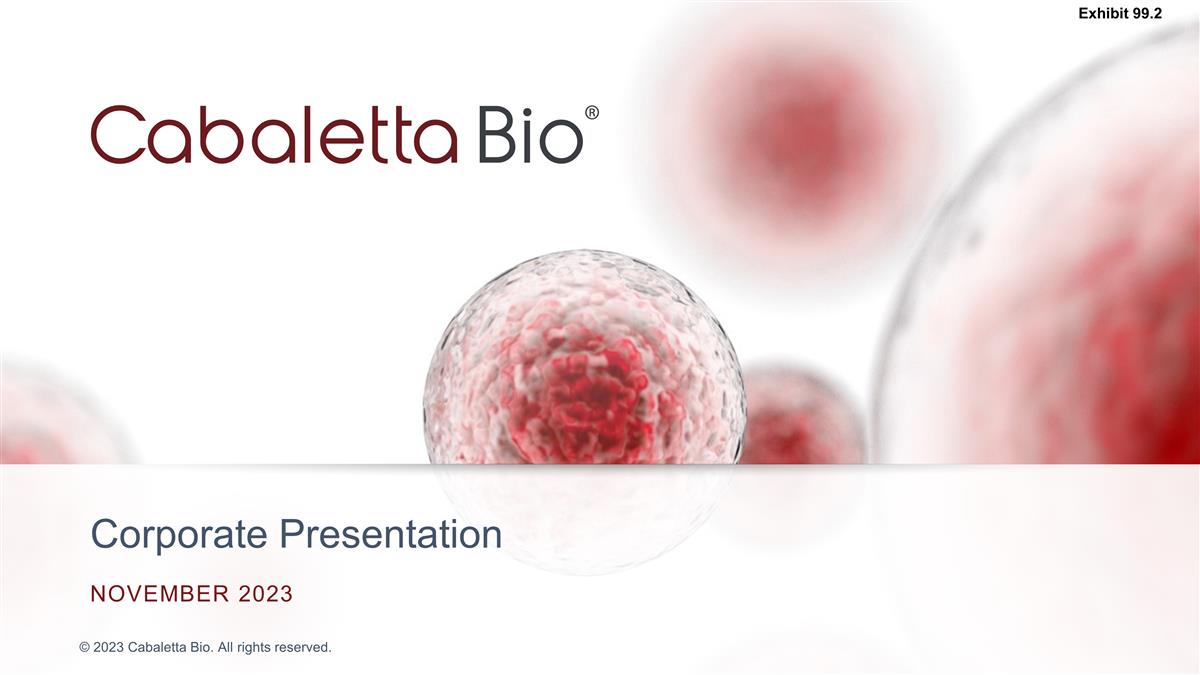
Corporate Presentation NOVEMBER 2023
Exhibit 99.2

Disclaimer The following presentation,
including any printed or electronic copy of these slides, the talks given by the presenters, the information communicated during any delivery of the presentation and any question and answer session and any document or material distributed at or in
connection with the presentation (collectively, the “Presentation”) has been prepared by Cabaletta Bio, Inc. (“we,” “us,” “our,” “Cabaletta” or the “Company”) and is made for
informational purposes only. This Presentation does not purport to be a prospectus, to be complete or to contain all of the information you may desire. Statements contained herein are made as of the date of this Presentation unless stated otherwise,
and this Presentation shall not under any circumstances create an implication that the information contained herein is correct as of any time after such date or that information will be updated or revised to reflect information that subsequently
becomes available or changes occurring after the date hereof. This Presentation may contain “forward-looking statements” within the meaning of the Private Securities Litigation Reform Act of 1995 relating to our business, operations, and
financial conditions, and include, but are not limited to, express or implied statements regarding our current beliefs, expectations and assumptions regarding: our business, future plans and strategies for our CAAR T and CARTA technologies and
CABA™ platform; our ability to grow our autoimmune-focused pipeline; the ability to capitalize on and potential benefits resulting from (i) the translational research partnership with Professor Georg Schett; (ii) the exclusive license
agreement with IASO Bio; and (iii) the published systemic sclerosis (SSc) case report in a CD19-CAR T treated patient with SSc; the anticipated market opportunities for CABA-201 in SSc patients; the Company’s business plans and objectives; our
expectations around the potential success and therapeutic benefits of CABA-201, including our belief that CABA-201 may enable an “immune system reset” and provide deep and durable responses for patients with autoimmune diseases; our
plans for Phase 1/2 clinical trials of CABA-201 in patients with systemic lupus erythematosus (SLE), myositis, SSc, and generalized myasthenia gravis (gMG) including our anticipated progress, clinical trial design, and ability to leverage our
experience in autoimmune cell therapy; our planned initial clinical data read-out in the first half of 2024 for patients treated with CABA-201; our ability to enroll the requisite number of patients, dose each dosing cohort in the intended manner,
and advance the trial as planned in our Phase 1/2 clinical trials of CABA-201; the ability to retain and recognize the intended incentives conferred by any Fast Track Designations for CABA-201; the timing any planned regulatory filings for our
development programs; the progress and results of our DesCAARTes™ Phase 1 trial, including the significance and impact around reported safety and clinical and translational data of cohorts from our DesCAARTes™ trial, and our ability to
advance dose escalation and initiate combination cohorts and to optimize our targeted cell therapy; our ability to implement a pre-treatment regimen, the outcomes of such pre-treatment regimen and the potential ability to enhance in vivo DSG3-CAART
exposure; the therapeutic potential and clinical benefits of our product candidates; the expectation that Cabaletta may improve outcomes for patients suffering from SLE, SSc, myositis, gMG, mucosal pemphigus vulgaris, MuSK myasthenia gravis, or
other autoimmune diseases; our ability to escalate dosing as high as 15 billion cells in cohort A6m, initiate dosing in a combination cohort or otherwise; our ability to evaluate, and the potential significance of, the relationship between
DSG3-CAART persistence and potential clinical responses in patients with mPV; our ability to safely retreat additional patients and whether we will continue to observe a lack of immune-mediated clearance of DSG3-CAART cells after retreatment and
repeat dosing of patients; our ability to successfully complete our preclinical and clinical studies for our product candidates, including our ability to enroll the requisite number of patients, dose each dosing cohort in the intended manner, and
progress the trial; the ability of MuSK-CAART to target B cells that differentiate into antibody secreting cells, which produce autoantibodies against muscle-specific kinase; our ability to obtain and maintain regulatory approval of our product
candidates, including our expectations regarding the intended incentives conferred by and ability to retain Orphan Drug Designation and Fast Track Designation for our product candidates, as applicable; the further expansion and development of our
modular CABA™ platform across a range of autoimmune diseases; our ability to accelerate our pipeline and to develop meaningful therapies for patients, including in collaboration with academic and industry partners and the ability to optimize
such collaborations on our development programs; our ability to contract with third-party suppliers and manufacturers, implement an enhanced manufacturing process and further develop our internal manufacturing strategy, capabilities and facilities;
our potential commercial opportunities, including value and addressable market, for our product candidates; our expectations regarding our use of capital and other financial results; and our ability to fund operations into the fourth quarter of
2025. Words such as, but not limited to, “look forward to,” “believe,” “expect,” “anticipate,” “estimate,” “intend,” “plan,” “would,”
“should” and “could,” and similar expressions or words, identify forward-looking statements. Various risks, uncertainties and assumptions could cause actual results to differ materially from those anticipated or implied in
our forward-looking statements. Such risks and uncertainties include, but are not limited to, risks related to the success, cost, and timing of our product candidate development activities and preclinical studies and clinical trials, risks related
to our ability to demonstrate sufficient evidence of safety, efficacy and tolerability in our preclinical studies and clinical trials of CABA-201, DSG3-CAART and MuSK-CAART, the risk that the results observed with the similarly-designed construct,
including, but not limited to, due to dosing regimen, are not indicative of the results we seek to achieve with CABA-201, our plans to evaluate additional cohorts in the DesCAARTes™ trial, including a cohort implementing a pre-treatment
regimen, the risk that signs of biologic activity or persistence may not inform long-term results, the risk that persistence observed with effective CART-19 oncology studies in combination with lymphodepletion is not indicative of, or applicable to,
clinical responses in patients with mPV, risks related to clinical trial site activation or enrollment rates that are lower than expected, our ability to protect and maintain our intellectual property position, risks related to our relationships
with third parties, uncertainties related to regulatory agencies’ evaluation of regulatory filings and other information related to our product candidates, our ability to retain and recognize the intended incentives conferred by any Orphan
Drug Designations and Fast Track Designations, risks related to regulatory filings and potential clearance, the risk that any one or more of our product candidates will not be successfully developed and commercialized, the risk that the results of
preclinical studies or clinical studies will not be predictive of future results in connection with future studies, and risks related to volatile market and economic conditions and public health crises. New risks and uncertainties may emerge from
time to time, and it is not possible to predict all risks and uncertainties. Except as required by applicable law, we do not plan to publicly update or revise any forward-looking statements contained herein, whether as a result of any new
information, future events, changed circumstances or otherwise. Although we believe the expectations reflected in such forward-looking statements are reasonable, we can give no assurance that such expectations will prove to be correct. Accordingly,
you are cautioned not to place undue reliance on these forward-looking statements. No representations or warranties (expressed or implied) are made about the accuracy of any such forward-looking statements. For a discussion of these and other risks
and uncertainties, and other important factors, any of which could cause our actual results to differ materially from those contained in the forward-looking statements, see the section entitled "Risk Factors" in our most recent annual report on Form
10-K, as well as discussions of potential risks, uncertainties, and other important factors in our other and subsequent filings with the Securities and Exchange Commission. Certain information contained in this Presentation relates to or is based on
studies, publications, surveys and other data obtained from third-party sources and the Company’s own internal estimates and research. While the Company believes these third-party sources to be reliable as of the date of this Presentation, it
has not independently verified, and makes no representation as to the adequacy, fairness, accuracy or completeness of, any information obtained from third-party sources. The Company is the owner of various trademarks, trade names and service marks.
Certain other trademarks, trade names and service marks appearing in this Presentation are the property of third parties. Solely for convenience, the trademarks and trade names in this Presentation are referred to without the ® and TM symbols,
but such references should not be construed as any indicator that their respective owners will not assert, to the fullest extent under applicable law, their rights thereto.

Develop and launch the first curative
targeted cellular therapies for patients with autoimmune diseases
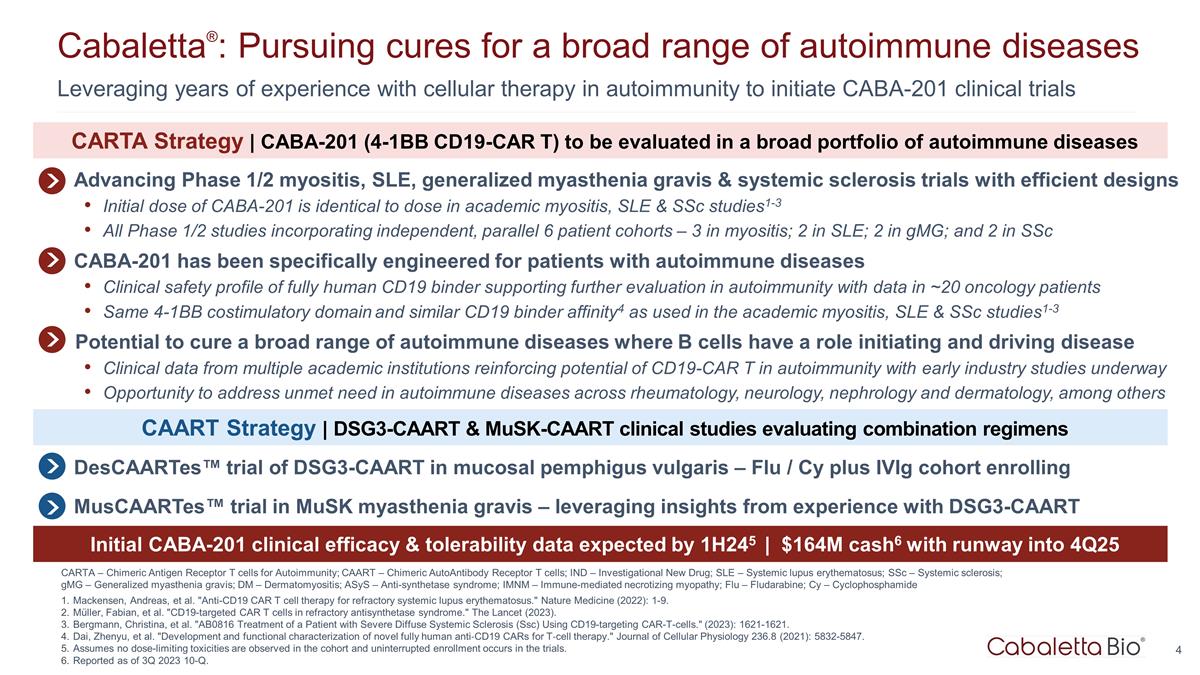
Leveraging years of experience with
cellular therapy in autoimmunity to initiate CABA-201 clinical trials Cabaletta®: Pursuing cures for a broad range of autoimmune diseases CARTA – Chimeric Antigen Receptor T cells for Autoimmunity; CAART – Chimeric AutoAntibody
Receptor T cells; IND – Investigational New Drug; SLE – Systemic lupus erythematosus; SSc – Systemic sclerosis; gMG – Generalized myasthenia gravis; DM – Dermatomyositis; ASyS – Anti-synthetase syndrome; IMNM
– Immune-mediated necrotizing myopathy; Flu – Fludarabine; Cy – Cyclophosphamide Mackensen, Andreas, et al. "Anti-CD19 CAR T cell therapy for refractory systemic lupus erythematosus." Nature Medicine (2022): 1-9. Müller,
Fabian, et al. "CD19-targeted CAR T cells in refractory antisynthetase syndrome." The Lancet (2023). Bergmann, Christina, et al. "AB0816 Treatment of a Patient with Severe Diffuse Systemic Sclerosis (Ssc) Using CD19-targeting CAR-T-cells." (2023):
1621-1621. Dai, Zhenyu, et al. "Development and functional characterization of novel fully human anti‐CD19 CARs for T‐cell therapy." Journal of Cellular Physiology 236.8 (2021): 5832-5847. Assumes no dose-limiting toxicities are observed
in the cohort and uninterrupted enrollment occurs in the trials. Reported as of 3Q 2023 10-Q. Advancing Phase 1/2 myositis, SLE, generalized myasthenia gravis & systemic sclerosis trials with efficient designs Initial dose of CABA-201 is
identical to dose in academic myositis, SLE & SSc studies1-3 All Phase 1/2 studies incorporating independent, parallel 6 patient cohorts – 3 in myositis; 2 in SLE; 2 in gMG; and 2 in SSc CABA-201 has been specifically engineered for
patients with autoimmune diseases Clinical safety profile of fully human CD19 binder supporting further evaluation in autoimmunity with data in ~20 oncology patients Same 4-1BB costimulatory domain and similar CD19 binder affinity4 as used in the
academic myositis, SLE & SSc studies1-3 Potential to cure a broad range of autoimmune diseases where B cells have a role initiating and driving disease Clinical data from multiple academic institutions reinforcing potential of CD19-CAR T in
autoimmunity with early industry studies underway Opportunity to address unmet need in autoimmune diseases across rheumatology, neurology, nephrology and dermatology, among others DesCAARTes™ trial of DSG3-CAART in mucosal pemphigus
vulgaris – Flu / Cy plus IVIg cohort enrolling MusCAARTes™ trial in MuSK myasthenia gravis – leveraging insights from experience with DSG3-CAART CARTA Strategy | CABA-201 (4-1BB CD19-CAR T) to be evaluated in a broad portfolio
of autoimmune diseases CAART Strategy | DSG3-CAART & MuSK-CAART clinical studies evaluating combination regimens Initial CABA-201 clinical efficacy & tolerability data expected by 1H245 | $164M cash6 with runway into
4Q25
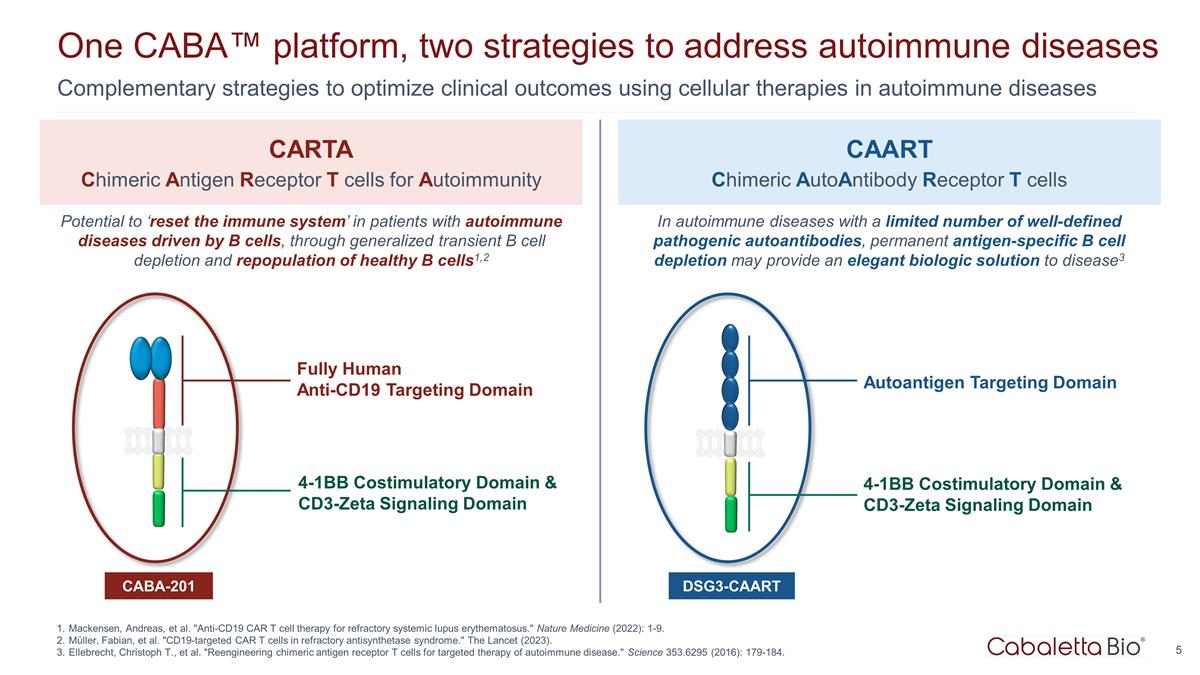
One CABA™ platform, two
strategies to address autoimmune diseases Complementary strategies to optimize clinical outcomes using cellular therapies in autoimmune diseases Mackensen, Andreas, et al. "Anti-CD19 CAR T cell therapy for refractory systemic lupus erythematosus."
Nature Medicine (2022): 1-9. Müller, Fabian, et al. "CD19-targeted CAR T cells in refractory antisynthetase syndrome." The Lancet (2023). Ellebrecht, Christoph T., et al. "Reengineering chimeric antigen receptor T cells for targeted therapy of
autoimmune disease." Science 353.6295 (2016): 179-184. Fully Human Anti-CD19 Targeting Domain CARTA Chimeric Antigen Receptor T cells for Autoimmunity CAART Chimeric AutoAntibody Receptor T cells CABA-201 4-1BB Costimulatory Domain &
CD3-Zeta Signaling Domain DSG3-CAART Potential to ‘reset the immune system’ in patients with autoimmune diseases driven by B cells, through generalized transient B cell depletion and repopulation of healthy B cells1,2 In autoimmune
diseases with a limited number of well-defined pathogenic autoantibodies, permanent antigen-specific B cell depletion may provide an elegant biologic solution to disease3 Autoantigen Targeting Domain 4-1BB Costimulatory Domain & CD3-Zeta
Signaling Domain
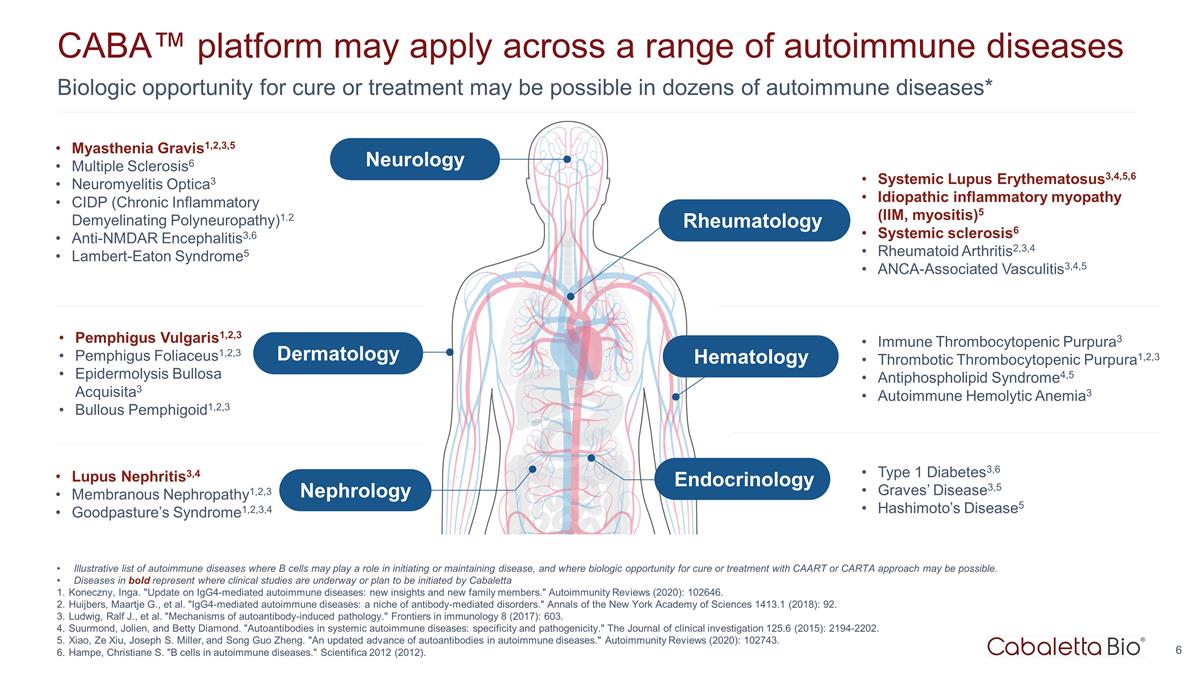
6 Biologic opportunity for cure or
treatment may be possible in dozens of autoimmune diseases* CABA™ platform may apply across a range of autoimmune diseases Illustrative list of autoimmune diseases where B cells may play a role in initiating or maintaining disease, and where
biologic opportunity for cure or treatment with CAART or CARTA approach may be possible. Diseases in bold represent where clinical studies are underway or plan to be initiated by Cabaletta Koneczny, Inga. "Update on IgG4-mediated autoimmune
diseases: new insights and new family members." Autoimmunity Reviews (2020): 102646. Huijbers, Maartje G., et al. "IgG4-mediated autoimmune diseases: a niche of antibody-mediated disorders." Annals of the New York Academy of Sciences 1413.1 (2018):
92. Ludwig, Ralf J., et al. "Mechanisms of autoantibody-induced pathology." Frontiers in immunology 8 (2017): 603. Suurmond, Jolien, and Betty Diamond. "Autoantibodies in systemic autoimmune diseases: specificity and pathogenicity." The Journal of
clinical investigation 125.6 (2015): 2194-2202. Xiao, Ze Xiu, Joseph S. Miller, and Song Guo Zheng. "An updated advance of autoantibodies in autoimmune diseases." Autoimmunity Reviews (2020): 102743. Hampe, Christiane S. "B cells in autoimmune
diseases." Scientifica 2012 (2012). Pemphigus Vulgaris1,2,3 Pemphigus Foliaceus1,2,3 Epidermolysis Bullosa Acquisita3 Bullous Pemphigoid1,2,3 Lupus Nephritis3,4 Membranous Nephropathy1,2,3 Goodpasture’s Syndrome1,2,3,4 Myasthenia Gravis1,2,3,5
Multiple Sclerosis6 Neuromyelitis Optica3 CIDP (Chronic Inflammatory Demyelinating Polyneuropathy)1.2 Anti-NMDAR Encephalitis3,6 Lambert-Eaton Syndrome5 Systemic Lupus Erythematosus3,4,5,6 Idiopathic inflammatory myopathy (IIM, myositis)5 Systemic
sclerosis6 Rheumatoid Arthritis2,3,4 ANCA-Associated Vasculitis3,4,5 Immune Thrombocytopenic Purpura3 Thrombotic Thrombocytopenic Purpura1,2,3 Antiphospholipid Syndrome4,5 Autoimmune Hemolytic Anemia3 Type 1 Diabetes3,6 Graves’ Disease3,5
Hashimoto’s Disease5 Dermatology Nephrology Neurology Rheumatology Hematology Endocrinology
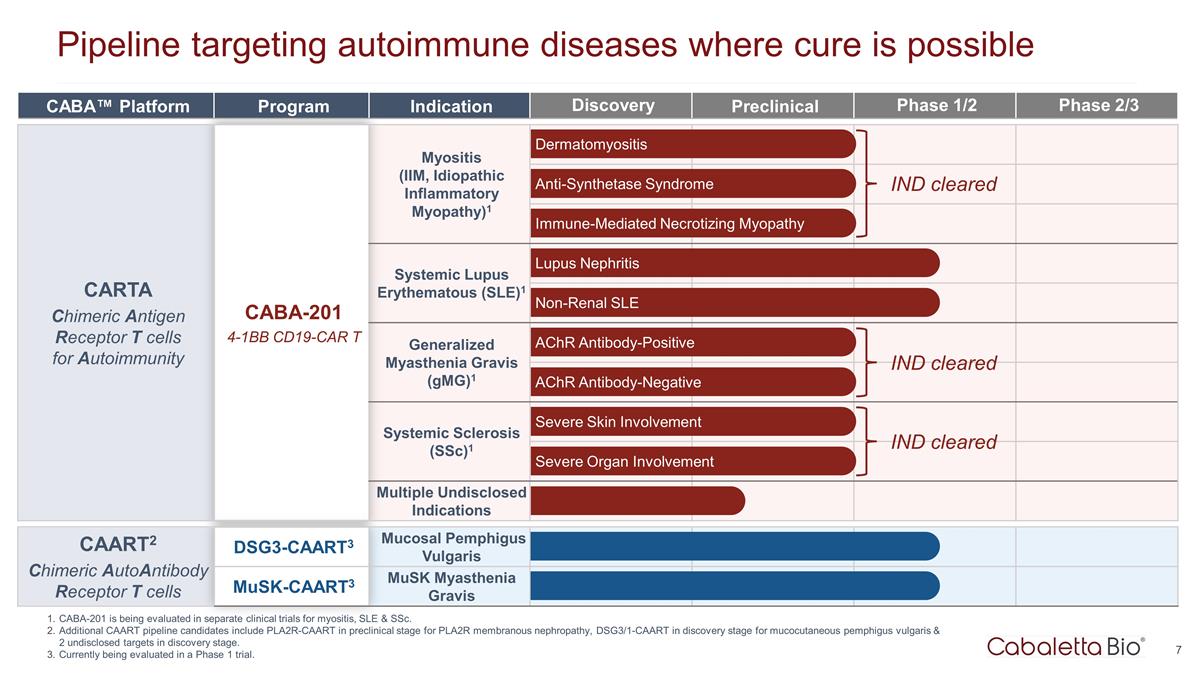
CABA™ Platform Program
Indication Discovery Preclinical Phase 1/2 Phase 2/3 CARTA Chimeric Antigen Receptor T cells for Autoimmunity CABA-201 4-1BB CD19-CAR T Myositis (IIM, Idiopathic Inflammatory Myopathy)1 CARTA Chimeric Antigen Receptor T cells for Autoimmunity
Systemic Lupus Erythematous (SLE)1 Systemic Lupus Erythematous (SLE)1 Systemic Sclerosis (SSc)1 Generalized Myasthenia Gravis (gMG)1 Generalized Myasthenia Gravis (gMG)1 Systemic Sclerosis (SSc)1 Multiple Undisclosed Indications Multiple Undisclosed
Indications CAART2 Chimeric AutoAntibody Receptor T cells DSG3-CAART3 Mucosal Pemphigus Vulgaris MuSK-CAART3 MuSK Myasthenia Gravis Pipeline targeting autoimmune diseases where cure is possible CABA-201 is being evaluated in separate clinical trials
for myositis, SLE & SSc. Additional CAART pipeline candidates include PLA2R-CAART in preclinical stage for PLA2R membranous nephropathy, DSG3/1-CAART in discovery stage for mucocutaneous pemphigus vulgaris & 2 undisclosed targets in
discovery stage. Currently being evaluated in a Phase 1 trial. Dermatomyositis Anti-Synthetase Syndrome Immune-Mediated Necrotizing Myopathy Lupus Nephritis Non-Renal SLE AChR Antibody-Positive AChR Antibody-Negative IND cleared Severe Skin
Involvement Severe Organ Involvement IND cleared IND cleared

Chimeric Antigen Receptor T Cells for
Autoimmunity CABA-201
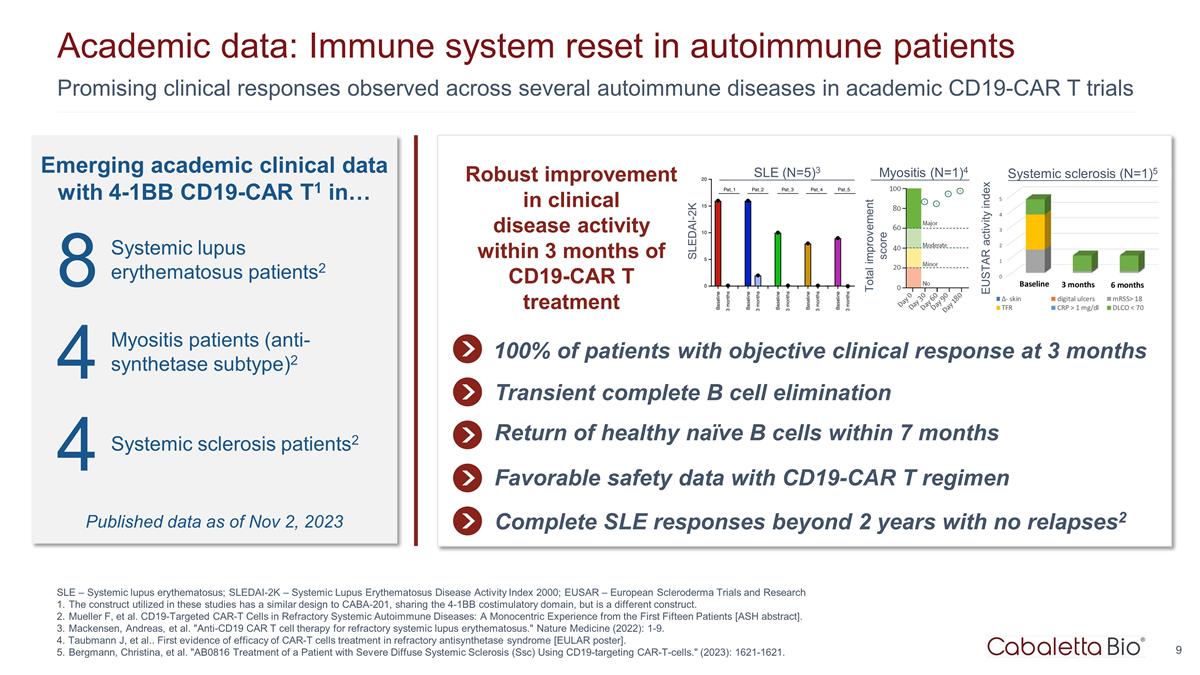
Emerging academic clinical data with
4-1BB CD19-CAR T1 in… SLE – Systemic lupus erythematosus; SLEDAI-2K – Systemic Lupus Erythematosus Disease Activity Index 2000; EUSAR – European Scleroderma Trials and Research The construct utilized in these studies has a
similar design to CABA-201, sharing the 4-1BB costimulatory domain, but is a different construct. Mueller F, et al. CD19-Targeted CAR-T Cells in Refractory Systemic Autoimmune Diseases: A Monocentric Experience from the First Fifteen Patients [ASH
abstract]. Mackensen, Andreas, et al. "Anti-CD19 CAR T cell therapy for refractory systemic lupus erythematosus." Nature Medicine (2022): 1-9. Taubmann J, et al.. First evidence of efficacy of CAR-T cells treatment in refractory antisynthetase
syndrome [EULAR poster]. Bergmann, Christina, et al. "AB0816 Treatment of a Patient with Severe Diffuse Systemic Sclerosis (Ssc) Using CD19-targeting CAR-T-cells." (2023): 1621-1621. 9 Promising clinical responses observed across several autoimmune
diseases in academic CD19-CAR T trials Academic data: Immune system reset in autoimmune patients Robust improvement in clinical disease activity within 3 months of CD19-CAR T treatment Transient complete B cell elimination Favorable safety data with
CD19-CAR T regimen Complete SLE responses beyond 2 years with no relapses2 8 Systemic lupus erythematosus patients2 4 Myositis patients (anti-synthetase subtype)2 4 Systemic sclerosis patients2 Published data as of Nov 2, 2023 100% of patients with
objective clinical response at 3 months SLE (N=5)3 SLEDAI-2K Systemic sclerosis (N=1)5 EUSTAR activity index Myositis (N=1)4 Total improvement score Return of healthy naïve B cells within 7 months
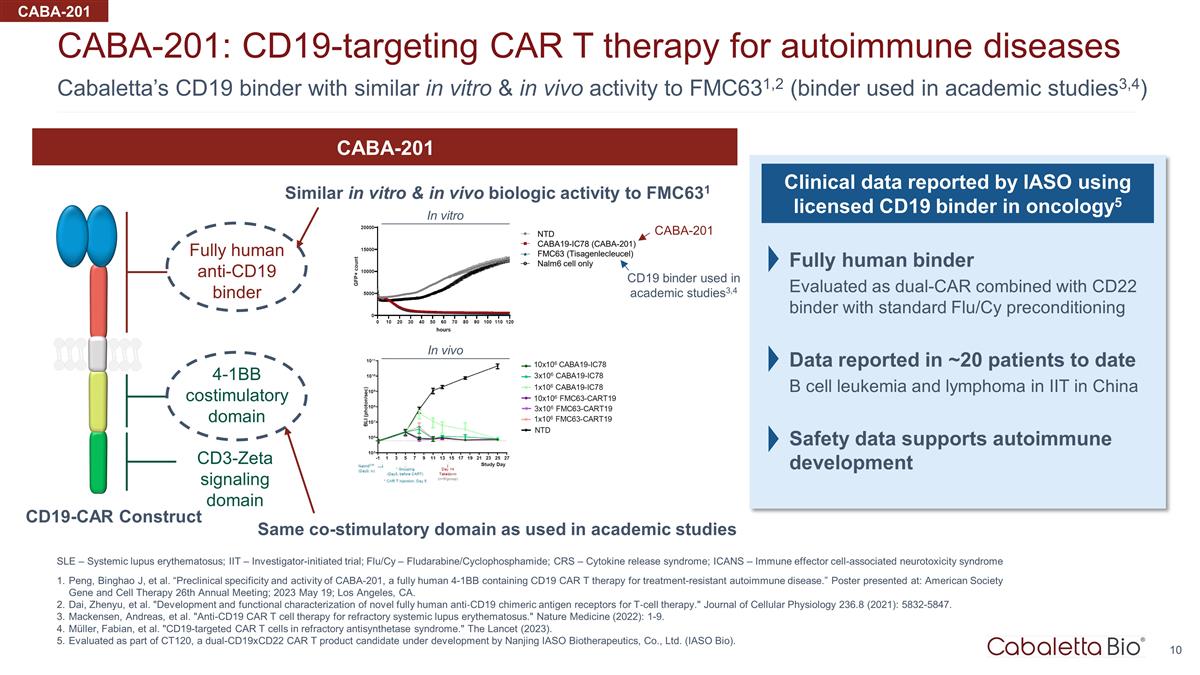
Cabaletta’s CD19 binder with
similar in vitro & in vivo activity to FMC631,2 (binder used in academic studies3,4) CABA-201: CD19-targeting CAR T therapy for autoimmune diseases SLE – Systemic lupus erythematosus; IIT – Investigator-initiated trial; Flu/Cy
– Fludarabine/Cyclophosphamide; CRS – Cytokine release syndrome; ICANS – Immune effector cell-associated neurotoxicity syndrome Peng, Binghao J, et al. “Preclinical specificity and activity of CABA-201, a fully human 4-1BB
containing CD19 CAR T therapy for treatment-resistant autoimmune disease.” Poster presented at: American Society Gene and Cell Therapy 26th Annual Meeting; 2023 May 19; Los Angeles, CA. Dai, Zhenyu, et al. "Development and functional
characterization of novel fully human anti‐CD19 chimeric antigen receptors for T‐cell therapy." Journal of Cellular Physiology 236.8 (2021): 5832-5847. Mackensen, Andreas, et al. "Anti-CD19 CAR T cell therapy for refractory systemic
lupus erythematosus." Nature Medicine (2022): 1-9. Müller, Fabian, et al. "CD19-targeted CAR T cells in refractory antisynthetase syndrome." The Lancet (2023). Evaluated as part of CT120, a dual-CD19xCD22 CAR T product candidate under
development by Nanjing IASO Biotherapeutics, Co., Ltd. (IASO Bio). Fully human anti-CD19 binder 4-1BB costimulatory domain CD3-Zeta signaling domain CABA-201 Similar in vitro & in vivo biologic activity to FMC631 Same co-stimulatory domain as
used in academic studies CD19-CAR Construct Clinical data reported by IASO using licensed CD19 binder in oncology5 Fully human binder Evaluated as dual-CAR combined with CD22 binder with standard Flu/Cy preconditioning Data reported in ~20 patients
to date B cell leukemia and lymphoma in IIT in China Safety data supports autoimmune development CABA-201 In vitro In vivo CABA-201 CD19 binder used in academic studies3,4
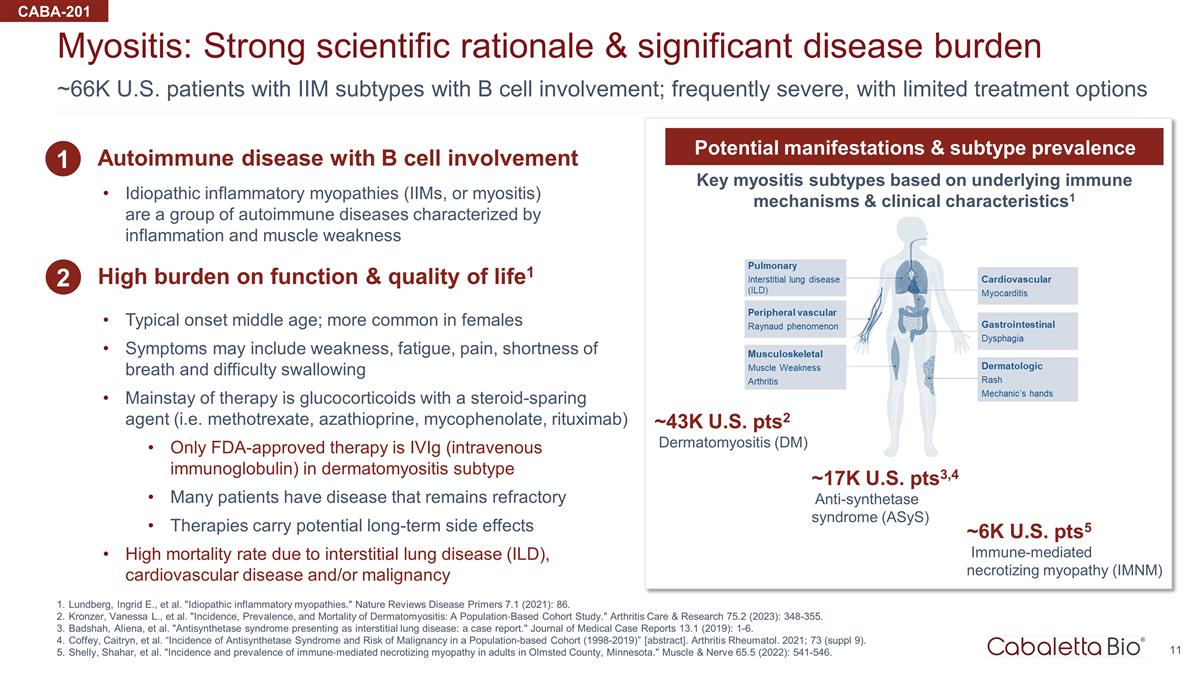
~66K U.S. patients with IIM
subtypes with B cell involvement; frequently severe, with limited treatment options Myositis: Strong scientific rationale & significant disease burden Lundberg, Ingrid E., et al. "Idiopathic inflammatory myopathies." Nature Reviews Disease
Primers 7.1 (2021): 86. Kronzer, Vanessa L., et al. "Incidence, Prevalence, and Mortality of Dermatomyositis: A Population‐Based Cohort Study." Arthritis Care & Research 75.2 (2023): 348-355. Badshah, Aliena, et al. "Antisynthetase
syndrome presenting as interstitial lung disease: a case report." Journal of Medical Case Reports 13.1 (2019): 1-6. Coffey, Caitryn, et al. “Incidence of Antisynthetase Syndrome and Risk of Malignancy in a Population-based Cohort
(1998-2019)” [abstract]. Arthritis Rheumatol. 2021; 73 (suppl 9). Shelly, Shahar, et al. "Incidence and prevalence of immune‐mediated necrotizing myopathy in adults in Olmsted County, Minnesota." Muscle & Nerve 65.5 (2022): 541-546.
~6K U.S. pts5 Immune-mediated necrotizing myopathy (IMNM) ~17K U.S. pts3,4 Anti-synthetase syndrome (ASyS) ~43K U.S. pts2 Dermatomyositis (DM) Key myositis subtypes based on underlying immune mechanisms & clinical characteristics1 Potential
manifestations & subtype prevalence 1 Autoimmune disease with B cell involvement 2 High burden on function & quality of life1 Idiopathic inflammatory myopathies (IIMs, or myositis) are a group of autoimmune diseases characterized by
inflammation and muscle weakness Typical onset middle age; more common in females Symptoms may include weakness, fatigue, pain, shortness of breath and difficulty swallowing Mainstay of therapy is glucocorticoids with a steroid-sparing agent (i.e.
methotrexate, azathioprine, mycophenolate, rituximab) Only FDA-approved therapy is IVIg (intravenous immunoglobulin) in dermatomyositis subtype Many patients have disease that remains refractory Therapies carry potential long-term side effects High
mortality rate due to interstitial lung disease (ILD), cardiovascular disease and/or malignancy CABA-201
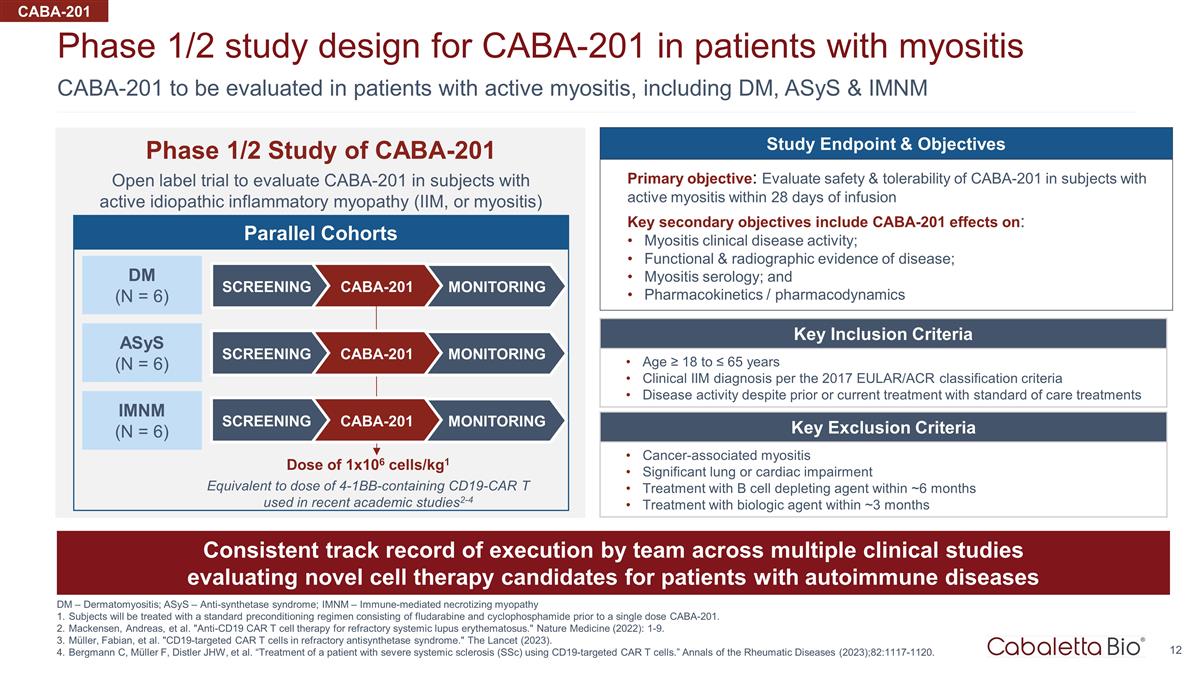
CABA-201 to be evaluated in
patients with active myositis, including DM, ASyS & IMNM Phase 1/2 study design for CABA-201 in patients with myositis DM – Dermatomyositis; ASyS – Anti-synthetase syndrome; IMNM – Immune-mediated necrotizing myopathy Subjects
will be treated with a standard preconditioning regimen consisting of fludarabine and cyclophosphamide prior to a single dose CABA-201. Mackensen, Andreas, et al. "Anti-CD19 CAR T cell therapy for refractory systemic lupus erythematosus." Nature
Medicine (2022): 1-9. Müller, Fabian, et al. "CD19-targeted CAR T cells in refractory antisynthetase syndrome." The Lancet (2023). Bergmann C, Müller F, Distler JHW, et al. “Treatment of a patient with severe systemic sclerosis (SSc)
using CD19-targeted CAR T cells.” Annals of the Rheumatic Diseases (2023);82:1117-1120. CABA-201 Key Inclusion Criteria Age ≥ 18 to ≤ 65 years Clinical IIM diagnosis per the 2017 EULAR/ACR classification criteria Disease activity
despite prior or current treatment with standard of care treatments Key Exclusion Criteria Cancer-associated myositis Significant lung or cardiac impairment Treatment with B cell depleting agent within ~6 months Treatment with biologic agent within
~3 months Study Endpoint & Objectives Primary objective: Evaluate safety & tolerability of CABA-201 in subjects with active myositis within 28 days of infusion Key secondary objectives include CABA-201 effects on: Myositis clinical disease
activity; Functional & radiographic evidence of disease; Myositis serology; and Pharmacokinetics / pharmacodynamics Consistent track record of execution by team across multiple clinical studies evaluating novel cell therapy candidates for
patients with autoimmune diseases Phase 1/2 Study of CABA-201 Open label trial to evaluate CABA-201 in subjects with active idiopathic inflammatory myopathy (IIM, or myositis) Parallel Cohorts SCREENING CABA-201 MONITORING Dose of 1x106 cells/kg1
Equivalent to dose of 4-1BB-containing CD19-CAR T used in recent academic studies2-4 ASyS (N = 6) IMNM (N = 6) DM (N = 6) SCREENING CABA-201 MONITORING SCREENING CABA-201 MONITORING
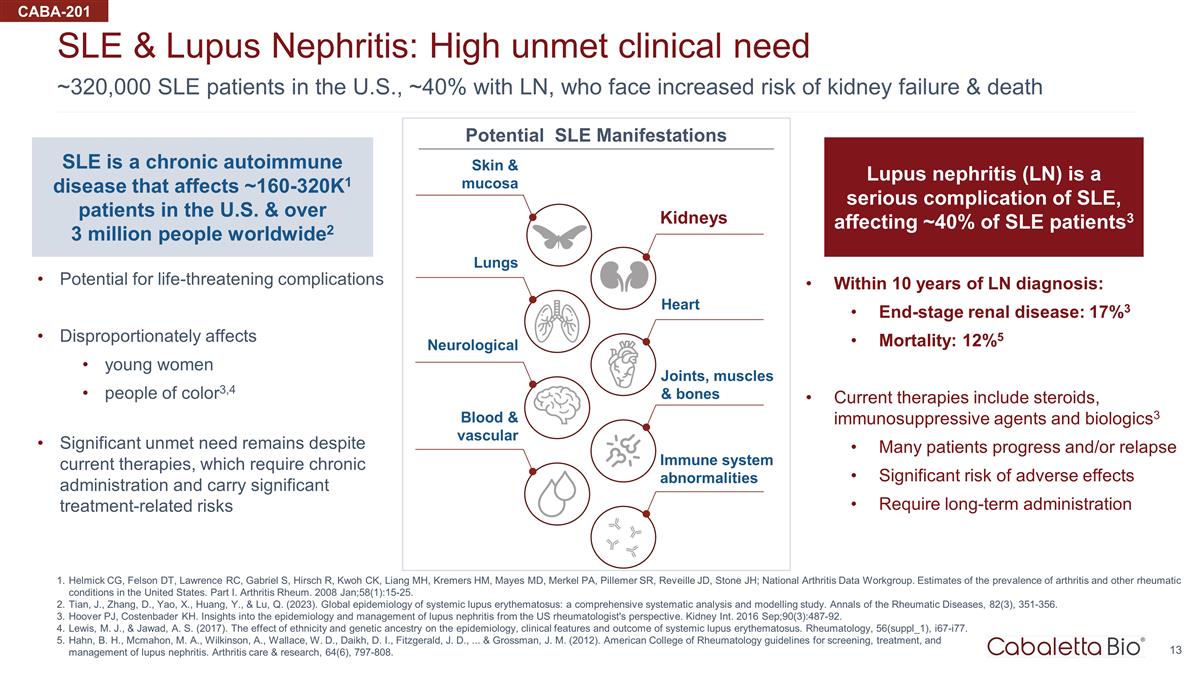
~320,000 SLE patients in the U.S.,
~40% with LN, who face increased risk of kidney failure & death SLE & Lupus Nephritis: High unmet clinical need Helmick CG, Felson DT, Lawrence RC, Gabriel S, Hirsch R, Kwoh CK, Liang MH, Kremers HM, Mayes MD, Merkel PA, Pillemer SR,
Reveille JD, Stone JH; National Arthritis Data Workgroup. Estimates of the prevalence of arthritis and other rheumatic conditions in the United States. Part I. Arthritis Rheum. 2008 Jan;58(1):15-25. Tian, J., Zhang, D., Yao, X., Huang, Y., & Lu,
Q. (2023). Global epidemiology of systemic lupus erythematosus: a comprehensive systematic analysis and modelling study. Annals of the Rheumatic Diseases, 82(3), 351-356. Hoover PJ, Costenbader KH. Insights into the epidemiology and management of
lupus nephritis from the US rheumatologist's perspective. Kidney Int. 2016 Sep;90(3):487-92. Lewis, M. J., & Jawad, A. S. (2017). The effect of ethnicity and genetic ancestry on the epidemiology, clinical features and outcome of systemic lupus
erythematosus. Rheumatology, 56(suppl_1), i67-i77. Hahn, B. H., Mcmahon, M. A., Wilkinson, A., Wallace, W. D., Daikh, D. I., Fitzgerald, J. D., ... & Grossman, J. M. (2012). American College of Rheumatology guidelines for screening, treatment,
and management of lupus nephritis. Arthritis care & research, 64(6), 797-808. CABA-201 Within 10 years of LN diagnosis: End-stage renal disease: 17%3 Mortality: 12%5 Current therapies include steroids, immunosuppressive agents and biologics3
Many patients progress and/or relapse Significant risk of adverse effects Require long-term administration SLE is a chronic autoimmune disease that affects ~160-320K1 patients in the U.S. & over 3 million people worldwide2 Potential for
life-threatening complications Disproportionately affects young women people of color3,4 Significant unmet need remains despite current therapies, which require chronic administration and carry significant treatment-related risks Lupus nephritis
(LN) is a serious complication of SLE, affecting ~40% of SLE patients3 Skin & mucosa Kidneys Heart Joints, muscles & bones Immune system abnormalities Blood & vascular Neurological Lungs Potential SLE Manifestations
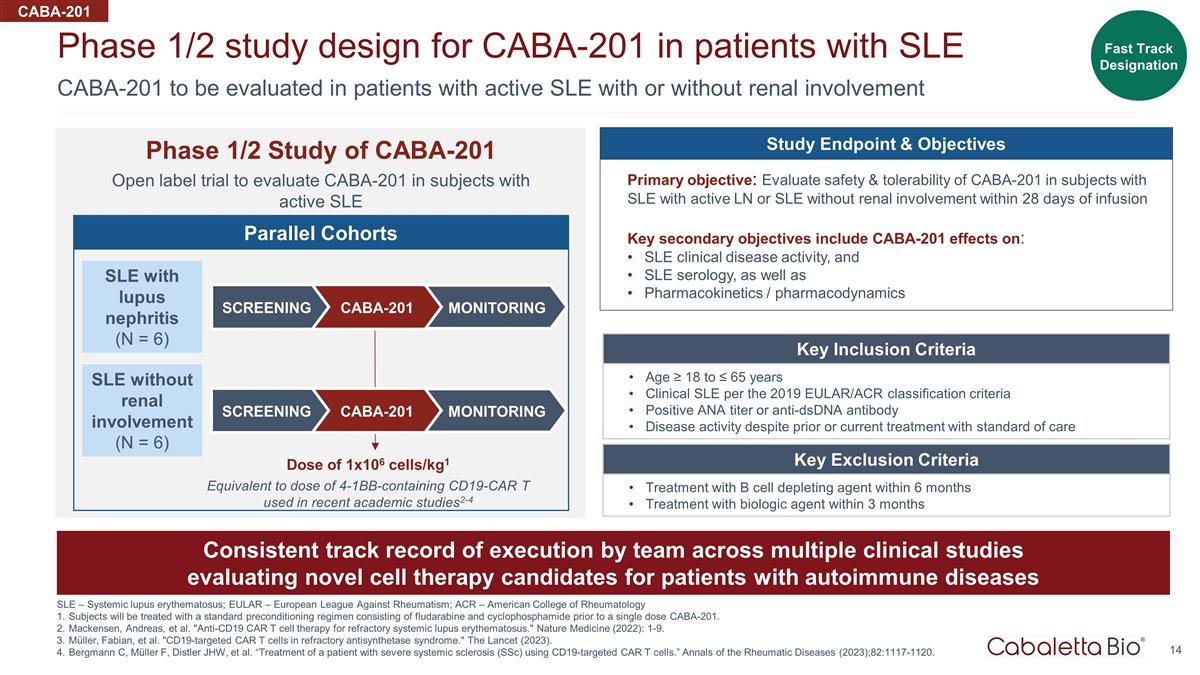
CABA-201 to be evaluated in
patients with active SLE with or without renal involvement Phase 1/2 study design for CABA-201 in patients with SLE SLE – Systemic lupus erythematosus; EULAR – European League Against Rheumatism; ACR – American College of
Rheumatology Subjects will be treated with a standard preconditioning regimen consisting of fludarabine and cyclophosphamide prior to a single dose CABA-201. Mackensen, Andreas, et al. "Anti-CD19 CAR T cell therapy for refractory systemic lupus
erythematosus." Nature Medicine (2022): 1-9. Müller, Fabian, et al. "CD19-targeted CAR T cells in refractory antisynthetase syndrome." The Lancet (2023). Bergmann C, Müller F, Distler JHW, et al. “Treatment of a patient with severe
systemic sclerosis (SSc) using CD19-targeted CAR T cells.” Annals of the Rheumatic Diseases (2023);82:1117-1120. CABA-201 Key Inclusion Criteria Age ≥ 18 to ≤ 65 years Clinical SLE per the 2019 EULAR/ACR classification criteria
Positive ANA titer or anti-dsDNA antibody Disease activity despite prior or current treatment with standard of care Key Exclusion Criteria Treatment with B cell depleting agent within 6 months Treatment with biologic agent within 3 months Consistent
track record of execution by team across multiple clinical studies evaluating novel cell therapy candidates for patients with autoimmune diseases Fast Track Designation Study Endpoint & Objectives Primary objective: Evaluate safety &
tolerability of CABA-201 in subjects with SLE with active LN or SLE without renal involvement within 28 days of infusion Key secondary objectives include CABA-201 effects on: SLE clinical disease activity, and SLE serology, as well as
Pharmacokinetics / pharmacodynamics Phase 1/2 Study of CABA-201 Open label trial to evaluate CABA-201 in subjects with active SLE Parallel Cohorts Dose of 1x106 cells/kg1 Equivalent to dose of 4-1BB-containing CD19-CAR T used in recent academic
studies2-4 SLE without renal involvement (N = 6) SLE with lupus nephritis (N = 6) SCREENING CABA-201 MONITORING SCREENING CABA-201 MONITORING
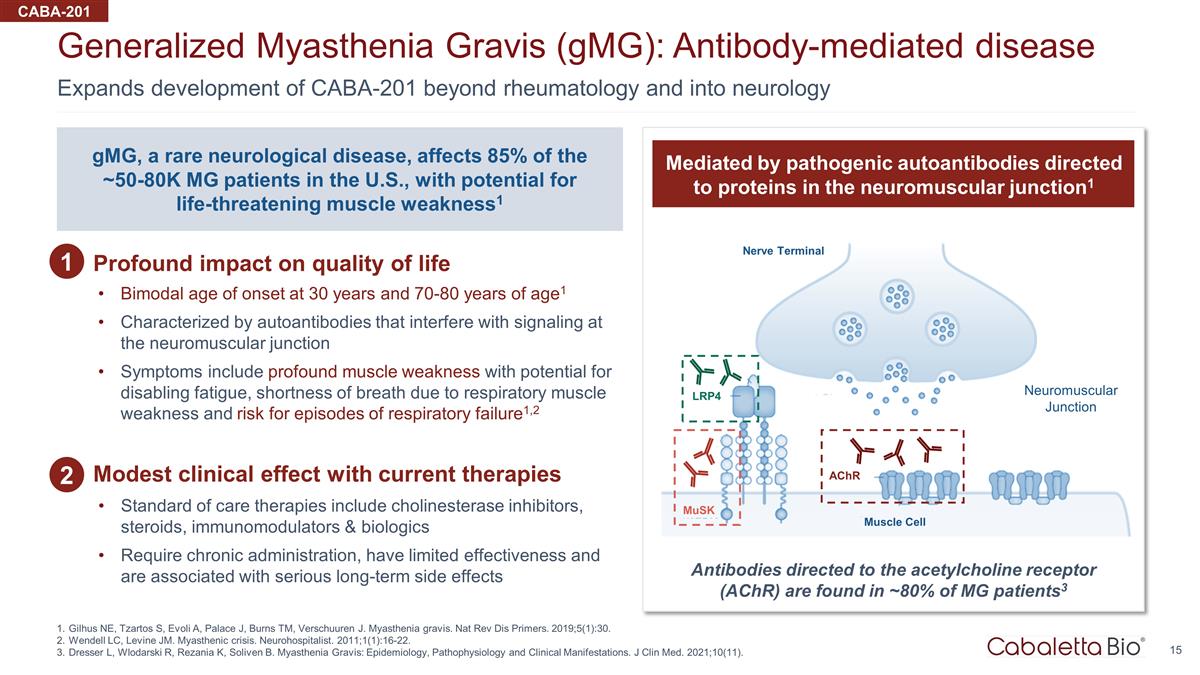
Expands development of CABA-201
beyond rheumatology and into neurology Generalized Myasthenia Gravis (gMG): Antibody-mediated disease Gilhus NE, Tzartos S, Evoli A, Palace J, Burns TM, Verschuuren J. Myasthenia gravis. Nat Rev Dis Primers. 2019;5(1):30. Wendell LC, Levine JM.
Myasthenic crisis. Neurohospitalist. 2011;1(1):16-22. Dresser L, Wlodarski R, Rezania K, Soliven B. Myasthenia Gravis: Epidemiology, Pathophysiology and Clinical Manifestations. J Clin Med. 2021;10(11). CABA-201 Bimodal age of onset at 30 years and
70-80 years of age1 Characterized by autoantibodies that interfere with signaling at the neuromuscular junction Symptoms include profound muscle weakness with potential for disabling fatigue, shortness of breath due to respiratory muscle weakness
and risk for episodes of respiratory failure1,2 Standard of care therapies include cholinesterase inhibitors, steroids, immunomodulators & biologics Require chronic administration, have limited effectiveness and are associated with serious
long-term side effects 1 Profound impact on quality of life Modest clinical effect with current therapies 2 Mediated by pathogenic autoantibodies directed to proteins in the neuromuscular junction1 gMG, a rare neurological disease, affects 85% of
the ~50-80K MG patients in the U.S., with potential for life-threatening muscle weakness1 Antibodies directed to the acetylcholine receptor (AChR) are found in ~80% of MG patients3 Neuromuscular Junction Nerve Terminal AChR MuSK Muscle Cell LRP4
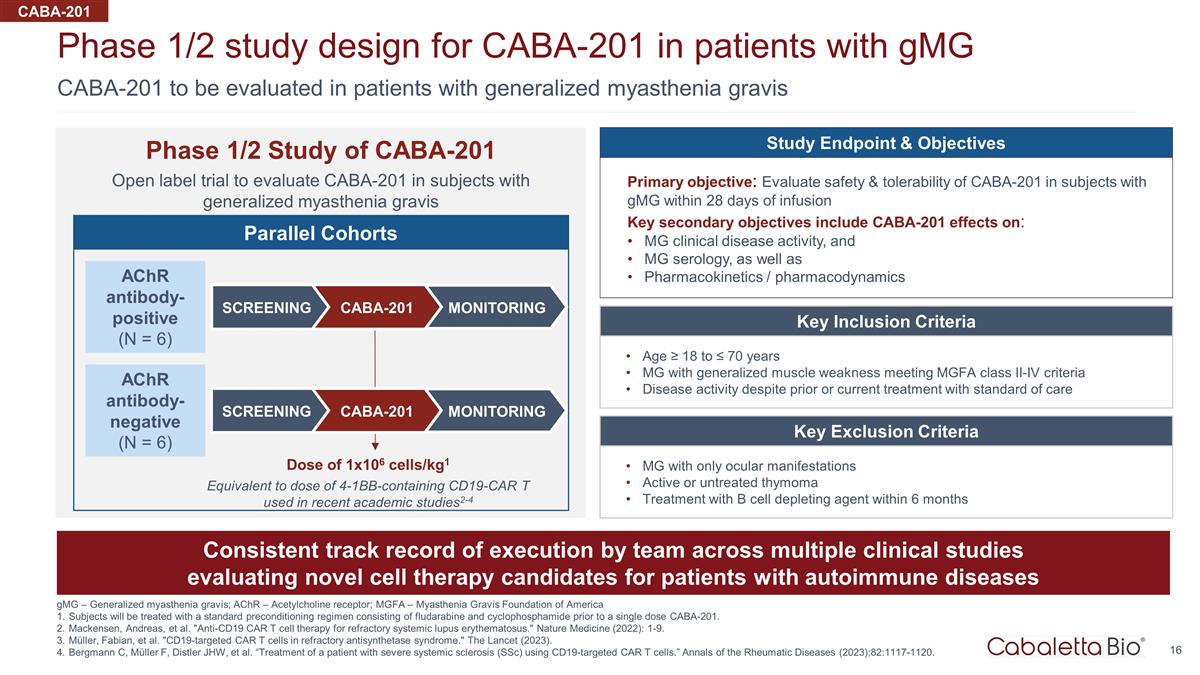
CABA-201 to be evaluated in
patients with generalized myasthenia gravis Phase 1/2 study design for CABA-201 in patients with gMG gMG – Generalized myasthenia gravis; AChR – Acetylcholine receptor; MGFA – Myasthenia Gravis Foundation of America Subjects will
be treated with a standard preconditioning regimen consisting of fludarabine and cyclophosphamide prior to a single dose CABA-201. Mackensen, Andreas, et al. "Anti-CD19 CAR T cell therapy for refractory systemic lupus erythematosus." Nature Medicine
(2022): 1-9. Müller, Fabian, et al. "CD19-targeted CAR T cells in refractory antisynthetase syndrome." The Lancet (2023). Bergmann C, Müller F, Distler JHW, et al. “Treatment of a patient with severe systemic sclerosis (SSc) using
CD19-targeted CAR T cells.” Annals of the Rheumatic Diseases (2023);82:1117-1120. CABA-201 Key Inclusion Criteria Age ≥ 18 to ≤ 70 years MG with generalized muscle weakness meeting MGFA class II-IV criteria Disease activity despite
prior or current treatment with standard of care Key Exclusion Criteria MG with only ocular manifestations Active or untreated thymoma Treatment with B cell depleting agent within 6 months Consistent track record of execution by team across multiple
clinical studies evaluating novel cell therapy candidates for patients with autoimmune diseases Fast Track Designation Study Endpoint & Objectives Primary objective: Evaluate safety & tolerability of CABA-201 in subjects with gMG within 28
days of infusion Key secondary objectives include CABA-201 effects on: MG clinical disease activity, and MG serology, as well as Pharmacokinetics / pharmacodynamics Phase 1/2 Study of CABA-201 Open label trial to evaluate CABA-201 in subjects with
generalized myasthenia gravis Parallel Cohorts Dose of 1x106 cells/kg1 Equivalent to dose of 4-1BB-containing CD19-CAR T used in recent academic studies2-4 AChR antibody-negative (N = 6) AChR antibody-positive (N = 6) SCREENING CABA-201 MONITORING
SCREENING CABA-201 MONITORING
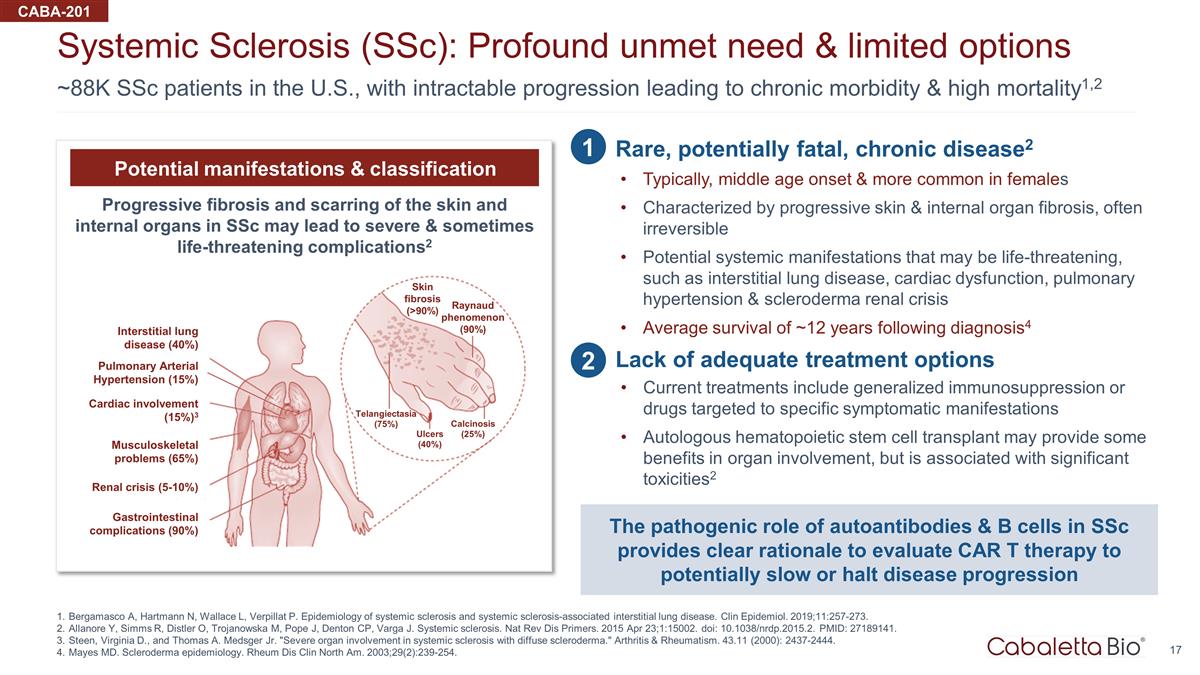
~88K SSc patients in the U.S., with
intractable progression leading to chronic morbidity & high mortality1,2 Systemic Sclerosis (SSc): Profound unmet need & limited options Bergamasco A, Hartmann N, Wallace L, Verpillat P. Epidemiology of systemic sclerosis and systemic
sclerosis-associated interstitial lung disease. Clin Epidemiol. 2019;11:257-273. Allanore Y, Simms R, Distler O, Trojanowska M, Pope J, Denton CP, Varga J. Systemic sclerosis. Nat Rev Dis Primers. 2015 Apr 23;1:15002. doi: 10.1038/nrdp.2015.2. PMID:
27189141. Steen, Virginia D., and Thomas A. Medsger Jr. "Severe organ involvement in systemic sclerosis with diffuse scleroderma." Arthritis & Rheumatism. 43.11 (2000): 2437-2444. Mayes MD. Scleroderma epidemiology. Rheum Dis Clin North Am.
2003;29(2):239-254. CABA-201 The pathogenic role of autoantibodies & B cells in SSc provides clear rationale to evaluate CAR T therapy to potentially slow or halt disease progression Typically, middle age onset & more common in females
Characterized by progressive skin & internal organ fibrosis, often irreversible Potential systemic manifestations that may be life-threatening, such as interstitial lung disease, cardiac dysfunction, pulmonary hypertension & scleroderma
renal crisis Average survival of ~12 years following diagnosis4 Current treatments include generalized immunosuppression or drugs targeted to specific symptomatic manifestations Autologous hematopoietic stem cell transplant may provide some benefits
in organ involvement, but is associated with significant toxicities2 1 Rare, potentially fatal, chronic disease2 Lack of adequate treatment options 2 Potential manifestations & classification Interstitial lung disease (40%) Pulmonary Arterial
Hypertension (15%) Musculoskeletal problems (65%) Renal crisis (5-10%) Gastrointestinal complications (90%) Calcinosis (25%) Ulcers (40%) Cardiac involvement (15%)3 Telangiectasia (75%) Raynaud phenomenon (90%) Skin fibrosis (>90%) Progressive
fibrosis and scarring of the skin and internal organs in SSc may lead to severe & sometimes life-threatening complications2
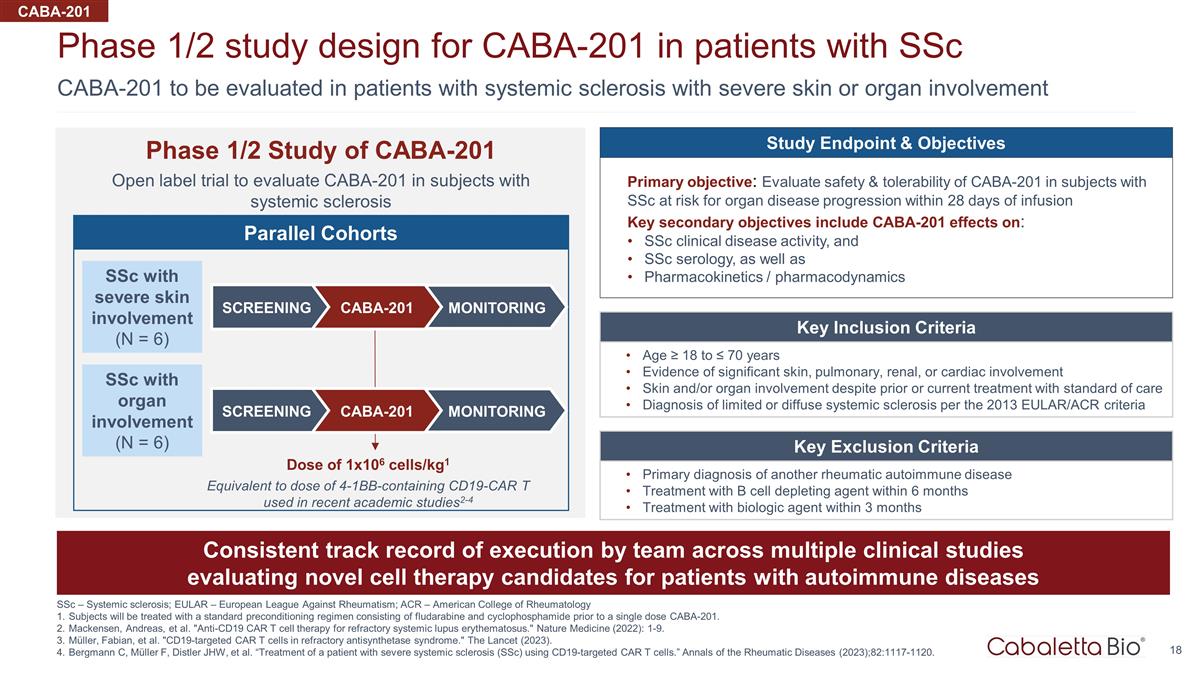
CABA-201 to be evaluated in
patients with systemic sclerosis with severe skin or organ involvement Phase 1/2 study design for CABA-201 in patients with SSc SSc – Systemic sclerosis; EULAR – European League Against Rheumatism; ACR – American College of
Rheumatology Subjects will be treated with a standard preconditioning regimen consisting of fludarabine and cyclophosphamide prior to a single dose CABA-201. Mackensen, Andreas, et al. "Anti-CD19 CAR T cell therapy for refractory systemic lupus
erythematosus." Nature Medicine (2022): 1-9. Müller, Fabian, et al. "CD19-targeted CAR T cells in refractory antisynthetase syndrome." The Lancet (2023). Bergmann C, Müller F, Distler JHW, et al. “Treatment of a patient with severe
systemic sclerosis (SSc) using CD19-targeted CAR T cells.” Annals of the Rheumatic Diseases (2023);82:1117-1120. CABA-201 Key Inclusion Criteria Age ≥ 18 to ≤ 70 years Evidence of significant skin, pulmonary, renal, or cardiac
involvement Skin and/or organ involvement despite prior or current treatment with standard of care Diagnosis of limited or diffuse systemic sclerosis per the 2013 EULAR/ACR criteria Key Exclusion Criteria Primary diagnosis of another rheumatic
autoimmune disease Treatment with B cell depleting agent within 6 months Treatment with biologic agent within 3 months Consistent track record of execution by team across multiple clinical studies evaluating novel cell therapy candidates for
patients with autoimmune diseases Fast Track Designation Study Endpoint & Objectives Primary objective: Evaluate safety & tolerability of CABA-201 in subjects with SSc at risk for organ disease progression within 28 days of infusion Key
secondary objectives include CABA-201 effects on: SSc clinical disease activity, and SSc serology, as well as Pharmacokinetics / pharmacodynamics Phase 1/2 Study of CABA-201 Open label trial to evaluate CABA-201 in subjects with systemic sclerosis
Parallel Cohorts Dose of 1x106 cells/kg1 Equivalent to dose of 4-1BB-containing CD19-CAR T used in recent academic studies2-4 SSc with organ involvement (N = 6) SSc with severe skin involvement (N = 6) SCREENING CABA-201 MONITORING SCREENING
CABA-201 MONITORING
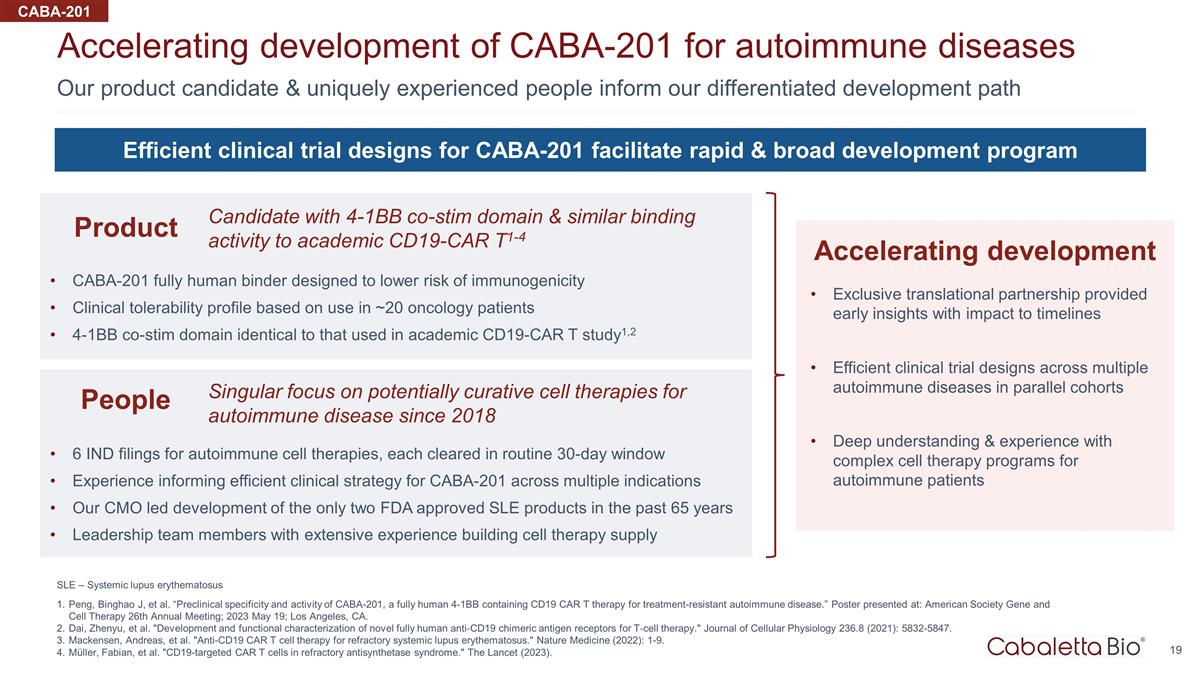
Our product candidate &
uniquely experienced people inform our differentiated development path Accelerating development of CABA-201 for autoimmune diseases SLE – Systemic lupus erythematosus Peng, Binghao J, et al. “Preclinical specificity and activity of
CABA-201, a fully human 4-1BB containing CD19 CAR T therapy for treatment-resistant autoimmune disease.” Poster presented at: American Society Gene and Cell Therapy 26th Annual Meeting; 2023 May 19; Los Angeles, CA. Dai, Zhenyu, et al.
"Development and functional characterization of novel fully human anti‐CD19 chimeric antigen receptors for T‐cell therapy." Journal of Cellular Physiology 236.8 (2021): 5832-5847. Mackensen, Andreas, et al. "Anti-CD19 CAR T cell therapy
for refractory systemic lupus erythematosus." Nature Medicine (2022): 1-9. Müller, Fabian, et al. "CD19-targeted CAR T cells in refractory antisynthetase syndrome." The Lancet (2023). CABA-201 Efficient clinical trial designs for CABA-201
facilitate rapid & broad development program Accelerating development Exclusive translational partnership provided early insights with impact to timelines Efficient clinical trial designs across multiple autoimmune diseases in parallel cohorts
Deep understanding & experience with complex cell therapy programs for autoimmune patients CABA-201 fully human binder designed to lower risk of immunogenicity Clinical tolerability profile based on use in ~20 oncology patients 4-1BB co-stim
domain identical to that used in academic CD19-CAR T study1,2 Product Candidate with 4-1BB co-stim domain & similar binding activity to academic CD19-CAR T1-4 6 IND filings for autoimmune cell therapies, each cleared in routine
30-day window Experience informing efficient clinical strategy for CABA-201 across multiple indications Our CMO led development of the only two FDA approved SLE products in the past 65 years Leadership team members with extensive
experience building cell therapy supply People Singular focus on potentially curative cell therapies for autoimmune disease since 2018

Chimeric AutoAntibody Receptor T
Cells DSG3-CAART & MuSK-CAART
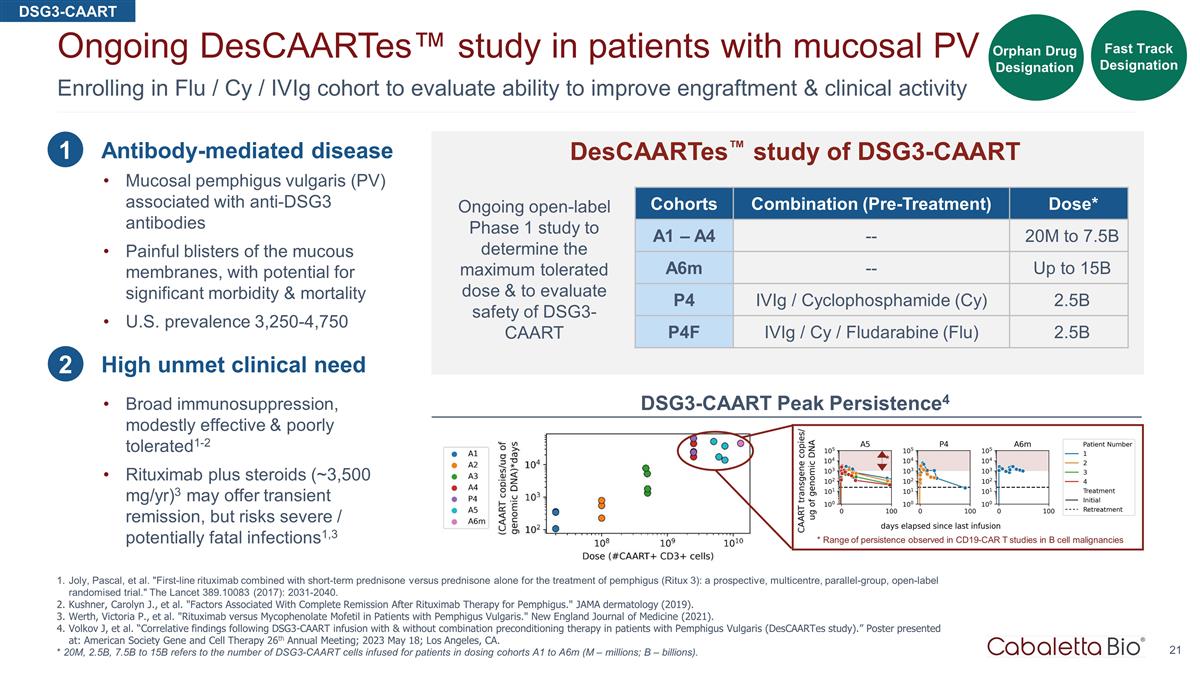
Enrolling in Flu / Cy / IVIg cohort
to evaluate ability to improve engraftment & clinical activity Ongoing DesCAARTes™ study in patients with mucosal PV Joly, Pascal, et al. "First-line rituximab combined with short-term prednisone versus prednisone alone for the treatment
of pemphigus (Ritux 3): a prospective, multicentre, parallel-group, open-label randomised trial." The Lancet 389.10083 (2017): 2031-2040. Kushner, Carolyn J., et al. "Factors Associated With Complete Remission After Rituximab Therapy for
Pemphigus." JAMA dermatology (2019). Werth, Victoria P., et al. "Rituximab versus Mycophenolate Mofetil in Patients with Pemphigus Vulgaris." New England Journal of Medicine (2021). Volkov J, et al. “Correlative findings following
DSG3-CAART infusion with & without combination preconditioning therapy in patients with Pemphigus Vulgaris (DesCAARTes study).” Poster presented at: American Society Gene and Cell Therapy 26th Annual Meeting; 2023 May 18; Los Angeles, CA.
* 20M, 2.5B, 7.5B to 15B refers to the number of DSG3-CAART cells infused for patients in dosing cohorts A1 to A6m (M – millions; B – billions). Fast Track Designation DSG3-CAART DesCAARTes™ study of DSG3-CAART Fast Track
Designation Orphan Drug Designation * Range of persistence observed in CD19-CAR T studies in B cell malignancies * DSG3-CAART Peak Persistence4 Cohorts Combination (Pre-Treatment) Dose* A1 – A4 -- 20M to 7.5B A6m -- Up to 15B P4 IVIg /
Cyclophosphamide (Cy) 2.5B P4F IVIg / Cy / Fludarabine (Flu) 2.5B Ongoing open-label Phase 1 study to determine the maximum tolerated dose & to evaluate safety of DSG3-CAART Mucosal pemphigus vulgaris (PV) associated with anti-DSG3 antibodies
Painful blisters of the mucous membranes, with potential for significant morbidity & mortality U.S. prevalence 3,250-4,750 1 2 Antibody-mediated disease High unmet clinical need Broad immunosuppression, modestly effective & poorly
tolerated1-2 Rituximab plus steroids (~3,500 mg/yr)3 may offer transient remission, but risks severe / potentially fatal infections1,3
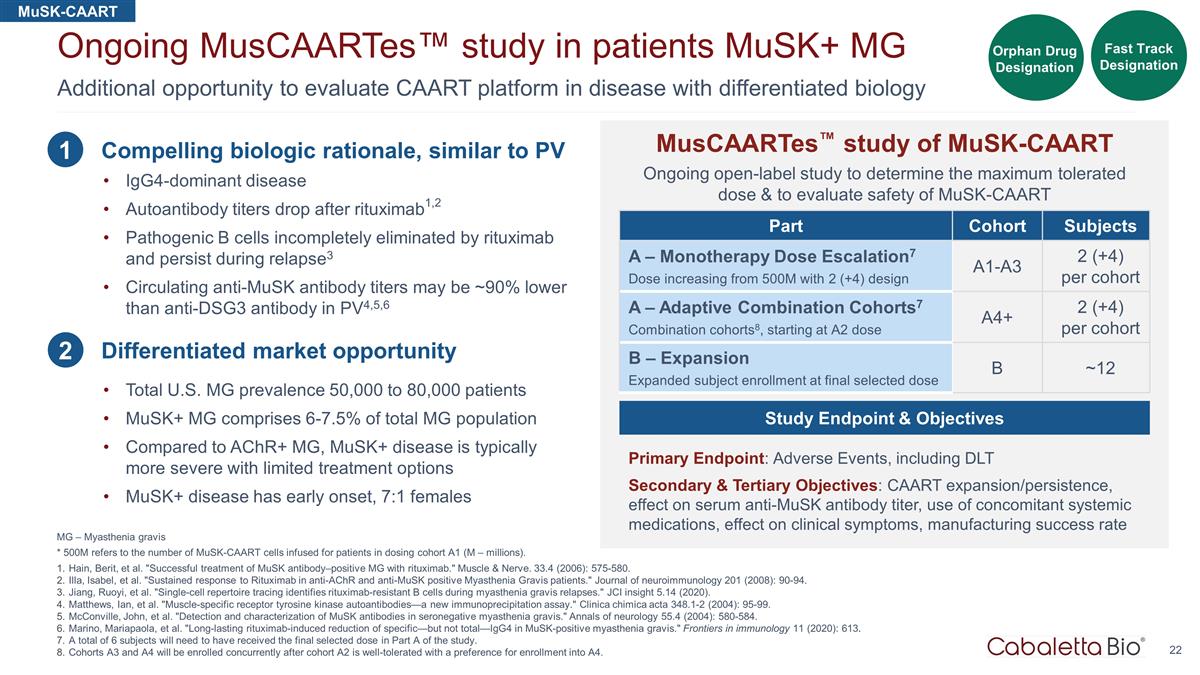
Additional opportunity to evaluate
CAART platform in disease with differentiated biology Ongoing MusCAARTes™ study in patients MuSK+ MG MusCAARTes™ study of MuSK-CAART Ongoing open-label study to determine the maximum tolerated dose & to evaluate safety of MuSK-CAART
Part Cohort Subjects A – Monotherapy Dose Escalation7 Dose increasing from 500M with 2 (+4) design A1-A3 2 (+4) per cohort A – Adaptive Combination Cohorts7 Combination cohorts8, starting at A2 dose A4+ 2 (+4) per cohort B –
Expansion Expanded subject enrollment at final selected dose B ~12 MuSK-CAART IgG4-dominant disease Autoantibody titers drop after rituximab1,2 Pathogenic B cells incompletely eliminated by rituximab and persist during relapse3 Circulating anti-MuSK
antibody titers may be ~90% lower than anti-DSG3 antibody in PV4,5,6 1 2 Study Endpoint & Objectives Primary Endpoint: Adverse Events, including DLT Secondary & Tertiary Objectives: CAART expansion/persistence, effect on serum anti-MuSK
antibody titer, use of concomitant systemic medications, effect on clinical symptoms, manufacturing success rate Compelling biologic rationale, similar to PV Differentiated market opportunity Total U.S. MG prevalence 50,000 to 80,000 patients MuSK+
MG comprises 6-7.5% of total MG population Compared to AChR+ MG, MuSK+ disease is typically more severe with limited treatment options MuSK+ disease has early onset, 7:1 females MG – Myasthenia gravis * 500M refers to the number of MuSK-CAART
cells infused for patients in dosing cohort A1 (M – millions). Hain, Berit, et al. "Successful treatment of MuSK antibody–positive MG with rituximab." Muscle & Nerve. 33.4 (2006): 575-580. Illa, Isabel, et al. "Sustained response to
Rituximab in anti-AChR and anti-MuSK positive Myasthenia Gravis patients." Journal of neuroimmunology 201 (2008): 90-94. Jiang, Ruoyi, et al. "Single-cell repertoire tracing identifies rituximab-resistant B cells during myasthenia gravis relapses."
JCI insight 5.14 (2020). Matthews, Ian, et al. "Muscle-specific receptor tyrosine kinase autoantibodies—a new immunoprecipitation assay." Clinica chimica acta 348.1-2 (2004): 95-99. McConville, John, et al. "Detection and characterization of
MuSK antibodies in seronegative myasthenia gravis." Annals of neurology 55.4 (2004): 580-584. Marino, Mariapaola, et al. "Long-lasting rituximab-induced reduction of specific—but not total—IgG4 in MuSK-positive myasthenia
gravis." Frontiers in immunology 11 (2020): 613. A total of 6 subjects will need to have received the final selected dose in Part A of the study. Cohorts A3 and A4 will be enrolled concurrently after cohort A2 is well-tolerated with a
preference for enrollment into A4. Fast Track Designation Orphan Drug Designation

Corporate Summary
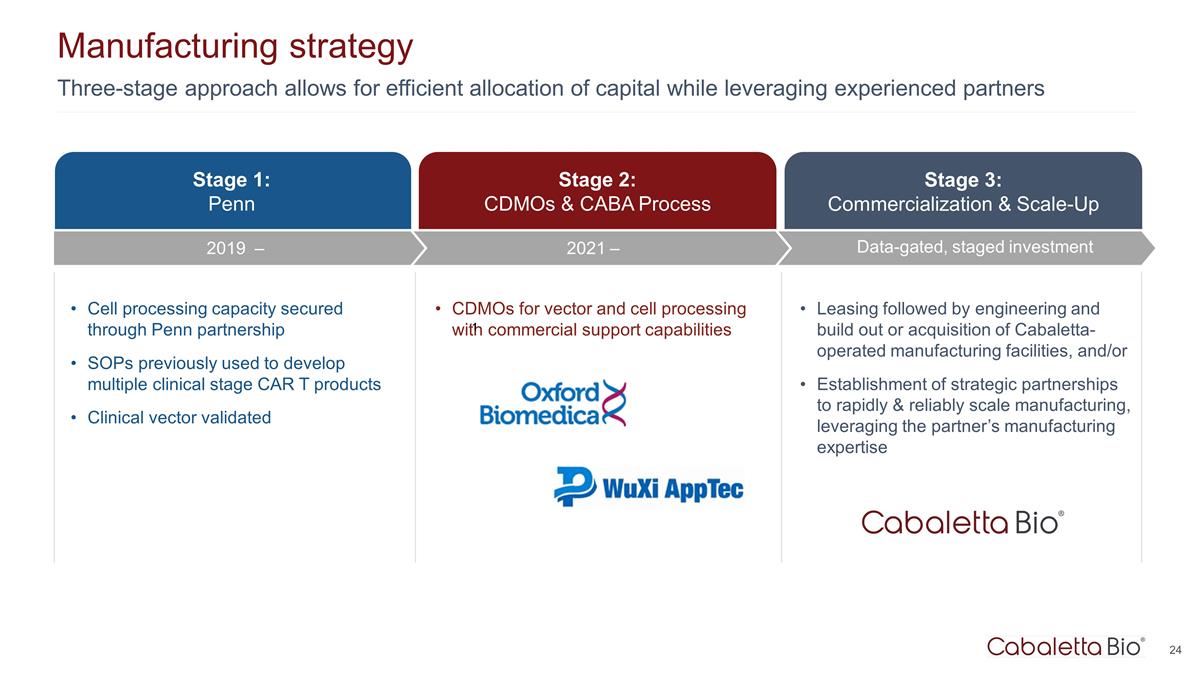
Three-stage approach allows for
efficient allocation of capital while leveraging experienced partners Manufacturing strategy Stage 3: Commercialization & Scale-Up Data-gated, staged investment Stage 1: Penn Stage 2: CDMOs & CABA Process Cell processing capacity secured
through Penn partnership SOPs previously used to develop multiple clinical stage CAR T products Clinical vector validated CDMOs for vector and cell processing with commercial support capabilities Leasing followed by engineering and build out or
acquisition of Cabaletta-operated manufacturing facilities, and/or Establishment of strategic partnerships to rapidly & reliably scale manufacturing, leveraging the partner’s manufacturing expertise 2021 – 2019 – 1
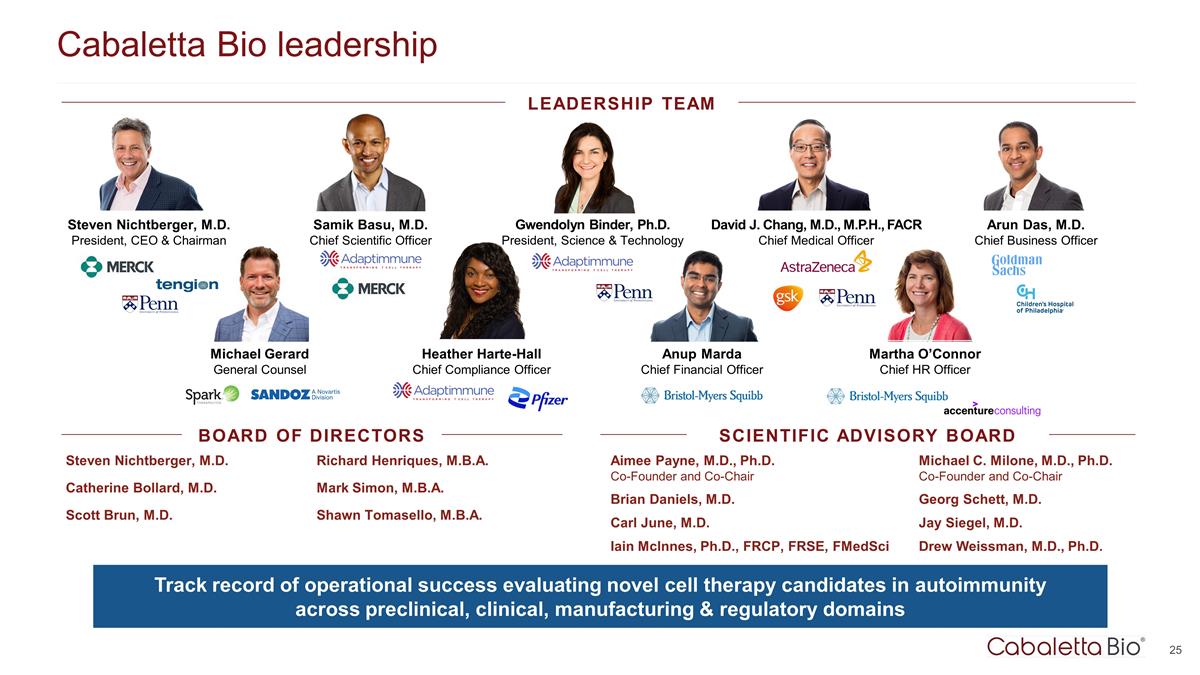
BOARD OF DIRECTORS Cabaletta Bio
leadership LEADERSHIP TEAM Anup Marda Chief Financial Officer Arun Das, M.D. Chief Business Officer David J. Chang, M.D., M.P.H., FACR Chief Medical Officer Martha O’Connor Chief HR Officer Michael Gerard General Counsel Steven Nichtberger,
M.D. President, CEO & Chairman Heather Harte-Hall Chief Compliance Officer Samik Basu, M.D. Chief Scientific Officer Gwendolyn Binder, Ph.D. President, Science & Technology SCIENTIFIC ADVISORY BOARD Track record of operational success
evaluating novel cell therapy candidates in autoimmunity across preclinical, clinical, manufacturing & regulatory domains Aimee Payne, M.D., Ph.D. Co-Founder and Co-Chair Michael C. Milone, M.D., Ph.D. Co-Founder and Co-Chair Carl June, M.D. Jay
Siegel, M.D. Brian Daniels, M.D. Steven Nichtberger, M.D. Richard Henriques, M.B.A. Scott Brun, M.D. Mark Simon, M.B.A. Catherine Bollard, M.D. Drew Weissman, M.D., Ph.D. Iain McInnes, Ph.D., FRCP, FRSE, FMedSci Georg Schett, M.D. Shawn Tomasello,
M.B.A.
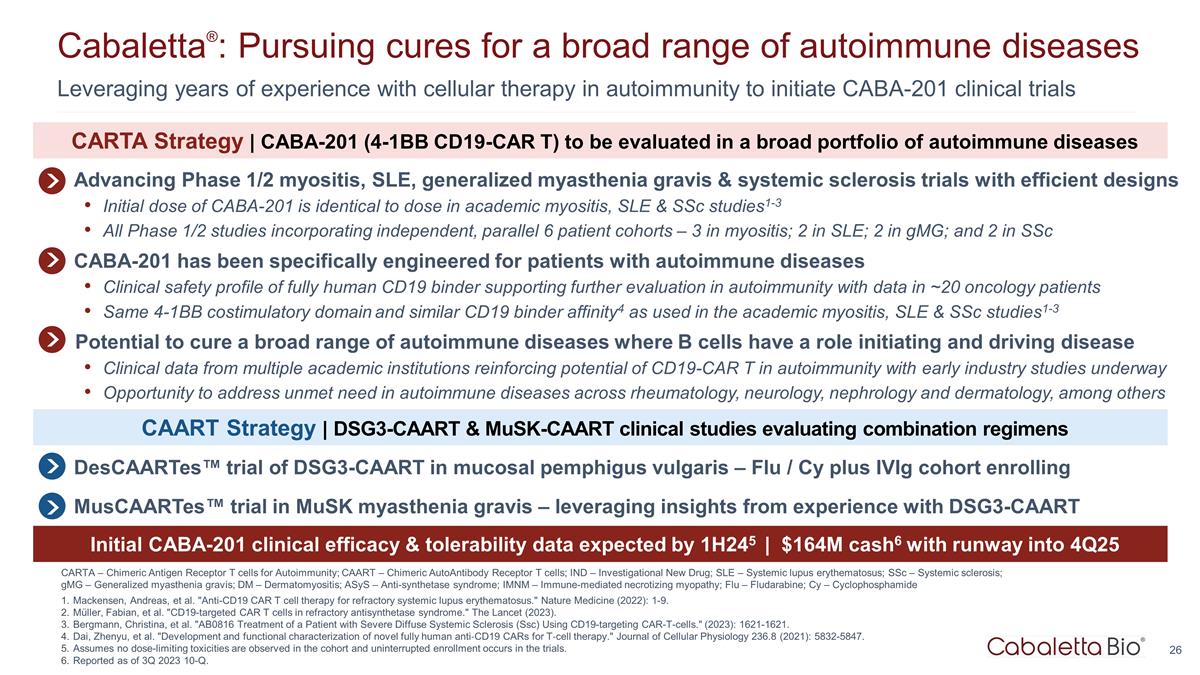
Leveraging years of experience with
cellular therapy in autoimmunity to initiate CABA-201 clinical trials Cabaletta®: Pursuing cures for a broad range of autoimmune diseases CARTA – Chimeric Antigen Receptor T cells for Autoimmunity; CAART – Chimeric AutoAntibody
Receptor T cells; IND – Investigational New Drug; SLE – Systemic lupus erythematosus; SSc – Systemic sclerosis; gMG – Generalized myasthenia gravis; DM – Dermatomyositis; ASyS – Anti-synthetase syndrome; IMNM
– Immune-mediated necrotizing myopathy; Flu – Fludarabine; Cy – Cyclophosphamide Mackensen, Andreas, et al. "Anti-CD19 CAR T cell therapy for refractory systemic lupus erythematosus." Nature Medicine (2022): 1-9. Müller,
Fabian, et al. "CD19-targeted CAR T cells in refractory antisynthetase syndrome." The Lancet (2023). Bergmann, Christina, et al. "AB0816 Treatment of a Patient with Severe Diffuse Systemic Sclerosis (Ssc) Using CD19-targeting CAR-T-cells." (2023):
1621-1621. Dai, Zhenyu, et al. "Development and functional characterization of novel fully human anti‐CD19 CARs for T‐cell therapy." Journal of Cellular Physiology 236.8 (2021): 5832-5847. Assumes no dose-limiting toxicities are observed
in the cohort and uninterrupted enrollment occurs in the trials. Reported as of 3Q 2023 10-Q. Advancing Phase 1/2 myositis, SLE, generalized myasthenia gravis & systemic sclerosis trials with efficient designs Initial dose of CABA-201 is
identical to dose in academic myositis, SLE & SSc studies1-3 All Phase 1/2 studies incorporating independent, parallel 6 patient cohorts – 3 in myositis; 2 in SLE; 2 in gMG; and 2 in SSc CABA-201 has been specifically engineered for
patients with autoimmune diseases Clinical safety profile of fully human CD19 binder supporting further evaluation in autoimmunity with data in ~20 oncology patients Same 4-1BB costimulatory domain and similar CD19 binder affinity4 as used in the
academic myositis, SLE & SSc studies1-3 Potential to cure a broad range of autoimmune diseases where B cells have a role initiating and driving disease Clinical data from multiple academic institutions reinforcing potential of CD19-CAR T in
autoimmunity with early industry studies underway Opportunity to address unmet need in autoimmune diseases across rheumatology, neurology, nephrology and dermatology, among others DesCAARTes™ trial of DSG3-CAART in mucosal pemphigus
vulgaris – Flu / Cy plus IVIg cohort enrolling MusCAARTes™ trial in MuSK myasthenia gravis – leveraging insights from experience with DSG3-CAART CARTA Strategy | CABA-201 (4-1BB CD19-CAR T) to be evaluated in a broad portfolio
of autoimmune diseases CAART Strategy | DSG3-CAART & MuSK-CAART clinical studies evaluating combination regimens Initial CABA-201 clinical efficacy & tolerability data expected by 1H245 | $164M cash6 with runway into
4Q25

Corporate Presentation NOVEMBER
2023
v3.23.3
| X |
- DefinitionBoolean flag that is true when the XBRL content amends previously-filed or accepted submission.
| Name: |
dei_AmendmentFlag |
| Namespace Prefix: |
dei_ |
| Data Type: |
xbrli:booleanItemType |
| Balance Type: |
na |
| Period Type: |
duration |
|
| X |
- DefinitionFor the EDGAR submission types of Form 8-K: the date of the report, the date of the earliest event reported; for the EDGAR submission types of Form N-1A: the filing date; for all other submission types: the end of the reporting or transition period. The format of the date is YYYY-MM-DD.
| Name: |
dei_DocumentPeriodEndDate |
| Namespace Prefix: |
dei_ |
| Data Type: |
xbrli:dateItemType |
| Balance Type: |
na |
| Period Type: |
duration |
|
| X |
- DefinitionThe type of document being provided (such as 10-K, 10-Q, 485BPOS, etc). The document type is limited to the same value as the supporting SEC submission type, or the word 'Other'.
| Name: |
dei_DocumentType |
| Namespace Prefix: |
dei_ |
| Data Type: |
dei:submissionTypeItemType |
| Balance Type: |
na |
| Period Type: |
duration |
|
| X |
- DefinitionAddress Line 1 such as Attn, Building Name, Street Name
| Name: |
dei_EntityAddressAddressLine1 |
| Namespace Prefix: |
dei_ |
| Data Type: |
xbrli:normalizedStringItemType |
| Balance Type: |
na |
| Period Type: |
duration |
|
| X |
- DefinitionAddress Line 2 such as Street or Suite number
| Name: |
dei_EntityAddressAddressLine2 |
| Namespace Prefix: |
dei_ |
| Data Type: |
xbrli:normalizedStringItemType |
| Balance Type: |
na |
| Period Type: |
duration |
|
| X |
- Definition
+ References
+ Details
| Name: |
dei_EntityAddressCityOrTown |
| Namespace Prefix: |
dei_ |
| Data Type: |
xbrli:normalizedStringItemType |
| Balance Type: |
na |
| Period Type: |
duration |
|
| X |
- DefinitionCode for the postal or zip code
| Name: |
dei_EntityAddressPostalZipCode |
| Namespace Prefix: |
dei_ |
| Data Type: |
xbrli:normalizedStringItemType |
| Balance Type: |
na |
| Period Type: |
duration |
|
| X |
- DefinitionName of the state or province.
| Name: |
dei_EntityAddressStateOrProvince |
| Namespace Prefix: |
dei_ |
| Data Type: |
dei:stateOrProvinceItemType |
| Balance Type: |
na |
| Period Type: |
duration |
|
| X |
- DefinitionA unique 10-digit SEC-issued value to identify entities that have filed disclosures with the SEC. It is commonly abbreviated as CIK. Reference 1: http://www.xbrl.org/2003/role/presentationRef
-Publisher SEC
-Name Exchange Act
-Number 240
-Section 12
-Subsection b-2
| Name: |
dei_EntityCentralIndexKey |
| Namespace Prefix: |
dei_ |
| Data Type: |
dei:centralIndexKeyItemType |
| Balance Type: |
na |
| Period Type: |
duration |
|
| X |
- DefinitionIndicate if registrant meets the emerging growth company criteria. Reference 1: http://www.xbrl.org/2003/role/presentationRef
-Publisher SEC
-Name Exchange Act
-Number 240
-Section 12
-Subsection b-2
| Name: |
dei_EntityEmergingGrowthCompany |
| Namespace Prefix: |
dei_ |
| Data Type: |
xbrli:booleanItemType |
| Balance Type: |
na |
| Period Type: |
duration |
|
| X |
- DefinitionCommission file number. The field allows up to 17 characters. The prefix may contain 1-3 digits, the sequence number may contain 1-8 digits, the optional suffix may contain 1-4 characters, and the fields are separated with a hyphen.
| Name: |
dei_EntityFileNumber |
| Namespace Prefix: |
dei_ |
| Data Type: |
dei:fileNumberItemType |
| Balance Type: |
na |
| Period Type: |
duration |
|
| X |
- DefinitionTwo-character EDGAR code representing the state or country of incorporation.
| Name: |
dei_EntityIncorporationStateCountryCode |
| Namespace Prefix: |
dei_ |
| Data Type: |
dei:edgarStateCountryItemType |
| Balance Type: |
na |
| Period Type: |
duration |
|
| X |
- DefinitionThe exact name of the entity filing the report as specified in its charter, which is required by forms filed with the SEC. Reference 1: http://www.xbrl.org/2003/role/presentationRef
-Publisher SEC
-Name Exchange Act
-Number 240
-Section 12
-Subsection b-2
| Name: |
dei_EntityRegistrantName |
| Namespace Prefix: |
dei_ |
| Data Type: |
xbrli:normalizedStringItemType |
| Balance Type: |
na |
| Period Type: |
duration |
|
| X |
- DefinitionThe Tax Identification Number (TIN), also known as an Employer Identification Number (EIN), is a unique 9-digit value assigned by the IRS. Reference 1: http://www.xbrl.org/2003/role/presentationRef
-Publisher SEC
-Name Exchange Act
-Number 240
-Section 12
-Subsection b-2
| Name: |
dei_EntityTaxIdentificationNumber |
| Namespace Prefix: |
dei_ |
| Data Type: |
dei:employerIdItemType |
| Balance Type: |
na |
| Period Type: |
duration |
|
| X |
- DefinitionLocal phone number for entity.
| Name: |
dei_LocalPhoneNumber |
| Namespace Prefix: |
dei_ |
| Data Type: |
xbrli:normalizedStringItemType |
| Balance Type: |
na |
| Period Type: |
duration |
|
| X |
- DefinitionBoolean flag that is true when the Form 8-K filing is intended to satisfy the filing obligation of the registrant as pre-commencement communications pursuant to Rule 13e-4(c) under the Exchange Act. Reference 1: http://www.xbrl.org/2003/role/presentationRef
-Publisher SEC
-Name Exchange Act
-Number 240
-Section 13e
-Subsection 4c
| Name: |
dei_PreCommencementIssuerTenderOffer |
| Namespace Prefix: |
dei_ |
| Data Type: |
xbrli:booleanItemType |
| Balance Type: |
na |
| Period Type: |
duration |
|
| X |
- DefinitionBoolean flag that is true when the Form 8-K filing is intended to satisfy the filing obligation of the registrant as pre-commencement communications pursuant to Rule 14d-2(b) under the Exchange Act. Reference 1: http://www.xbrl.org/2003/role/presentationRef
-Publisher SEC
-Name Exchange Act
-Number 240
-Section 14d
-Subsection 2b
| Name: |
dei_PreCommencementTenderOffer |
| Namespace Prefix: |
dei_ |
| Data Type: |
xbrli:booleanItemType |
| Balance Type: |
na |
| Period Type: |
duration |
|
| X |
- DefinitionTitle of a 12(b) registered security. Reference 1: http://www.xbrl.org/2003/role/presentationRef
-Publisher SEC
-Name Exchange Act
-Number 240
-Section 12
-Subsection b
| Name: |
dei_Security12bTitle |
| Namespace Prefix: |
dei_ |
| Data Type: |
dei:securityTitleItemType |
| Balance Type: |
na |
| Period Type: |
duration |
|
| X |
- DefinitionName of the Exchange on which a security is registered. Reference 1: http://www.xbrl.org/2003/role/presentationRef
-Publisher SEC
-Name Exchange Act
-Number 240
-Section 12
-Subsection d1-1
| Name: |
dei_SecurityExchangeName |
| Namespace Prefix: |
dei_ |
| Data Type: |
dei:edgarExchangeCodeItemType |
| Balance Type: |
na |
| Period Type: |
duration |
|
| X |
- DefinitionBoolean flag that is true when the Form 8-K filing is intended to satisfy the filing obligation of the registrant as soliciting material pursuant to Rule 14a-12 under the Exchange Act. Reference 1: http://www.xbrl.org/2003/role/presentationRef
-Publisher SEC
-Name Exchange Act
-Section 14a
-Number 240
-Subsection 12
| Name: |
dei_SolicitingMaterial |
| Namespace Prefix: |
dei_ |
| Data Type: |
xbrli:booleanItemType |
| Balance Type: |
na |
| Period Type: |
duration |
|
| X |
- DefinitionTrading symbol of an instrument as listed on an exchange.
| Name: |
dei_TradingSymbol |
| Namespace Prefix: |
dei_ |
| Data Type: |
dei:tradingSymbolItemType |
| Balance Type: |
na |
| Period Type: |
duration |
|
| X |
- DefinitionBoolean flag that is true when the Form 8-K filing is intended to satisfy the filing obligation of the registrant as written communications pursuant to Rule 425 under the Securities Act. Reference 1: http://www.xbrl.org/2003/role/presentationRef
-Publisher SEC
-Name Securities Act
-Number 230
-Section 425
| Name: |
dei_WrittenCommunications |
| Namespace Prefix: |
dei_ |
| Data Type: |
xbrli:booleanItemType |
| Balance Type: |
na |
| Period Type: |
duration |
|
Cabaletta Bio (NASDAQ:CABA)
Historical Stock Chart
From Mar 2024 to Apr 2024
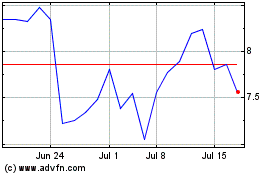
Cabaletta Bio (NASDAQ:CABA)
Historical Stock Chart
From Apr 2023 to Apr 2024
